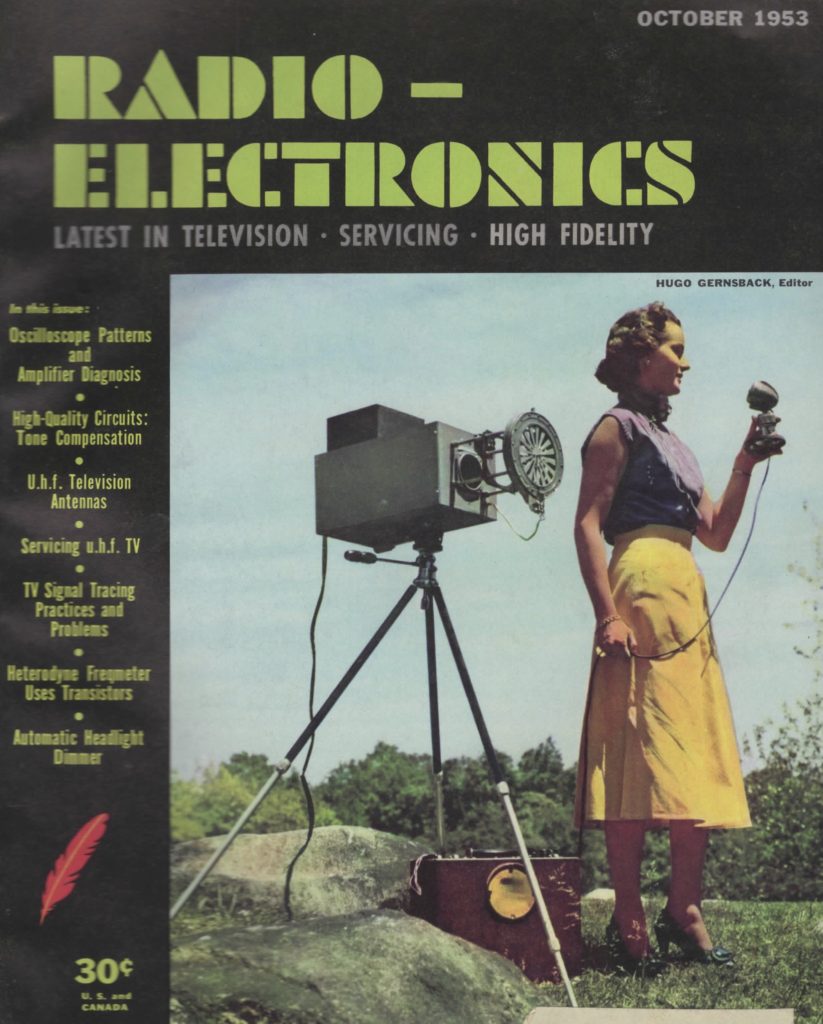
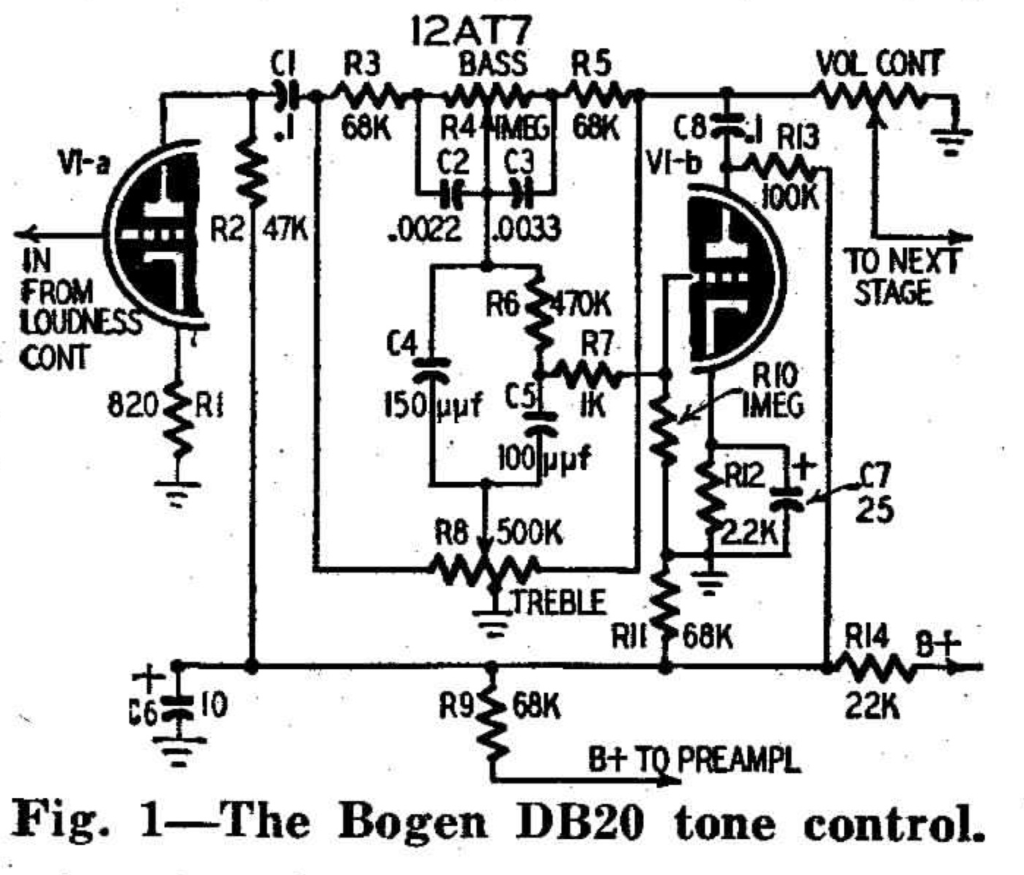
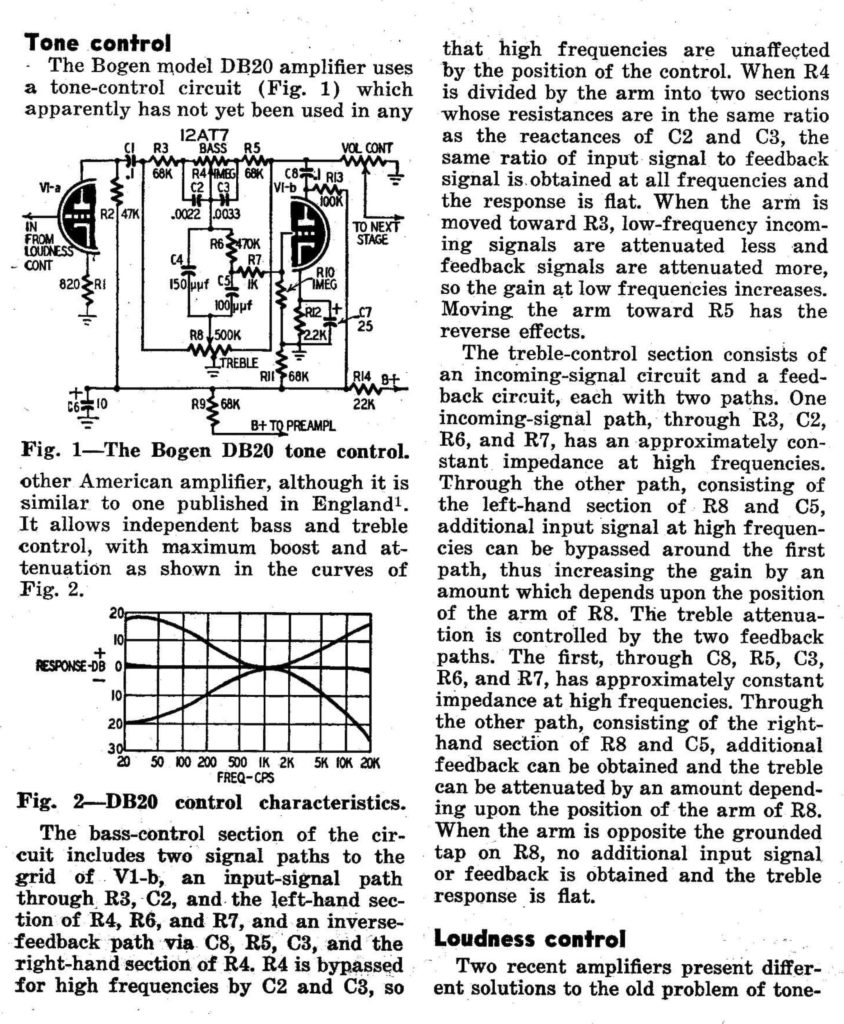



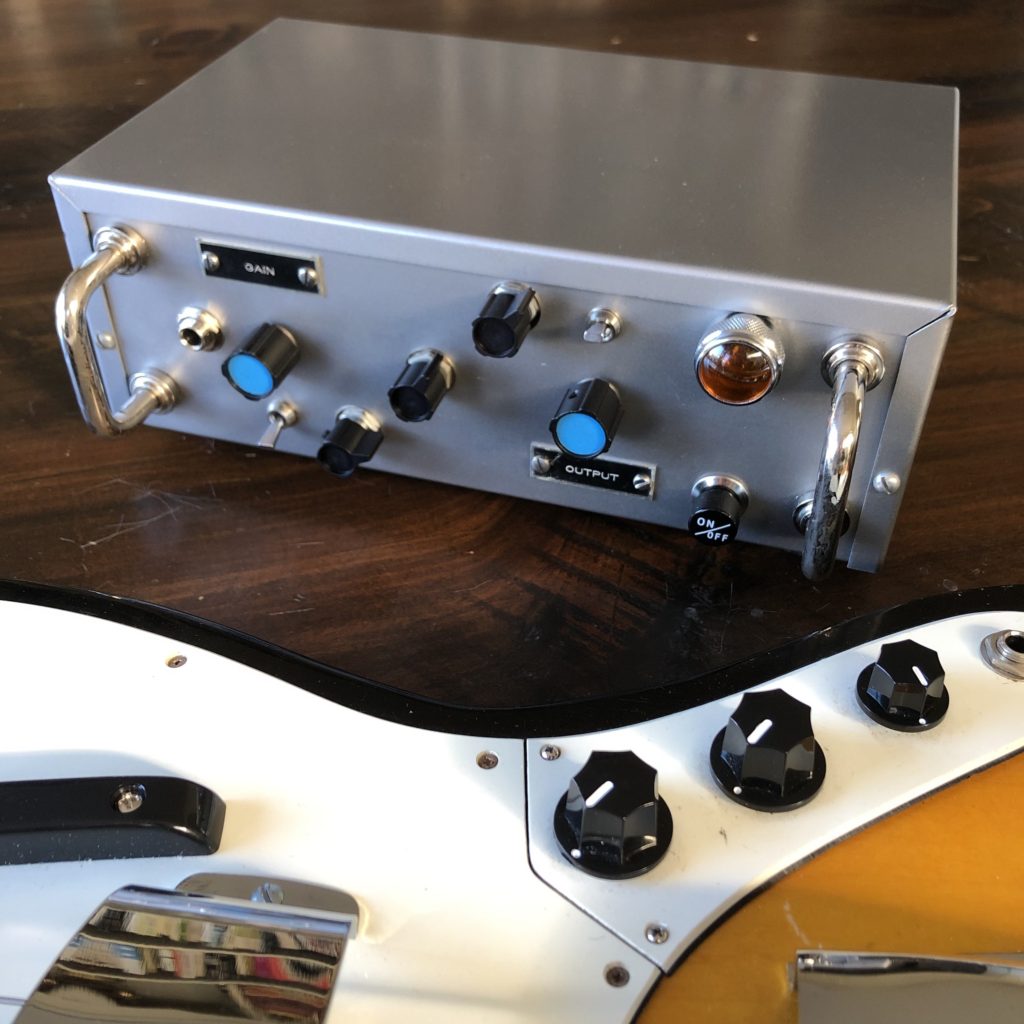
I tried to imagine the sort of custom instrument preamp that a top session player might have brought to a studio in The Seventies. Similar in principle to an Alembic F2B (part of many top players’ rigs for decades) but with many crucial improvements, this compact all-tube preamp starts with a classic Fender blackface low/mid/high/bright/vol feature set but adds the following: *master volume, *hi shift, and most importantly an additional output stage that can reliably drive a 10k input at high levels with no frequency loss.
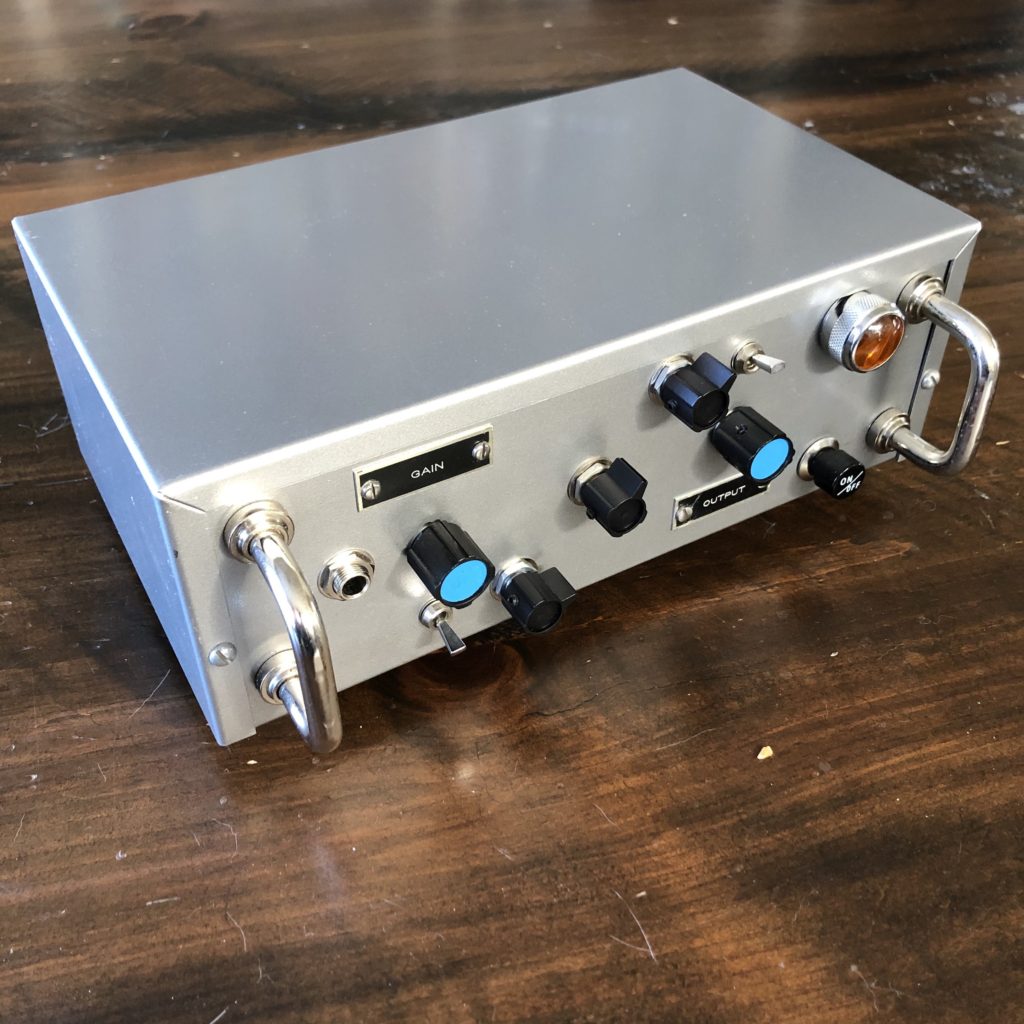
I learned a ton about the idiosyncratic Fender eq circuit by listening and fine-tuning this unit; the various compromises and ‘sweet spots’ that one can find with different cap and pot values. Basic three-stage filter power supply (output stage at 2nd leg) and c/t grounded AC heaters proved more than sufficient; the thing runs dead quiet (zero hum) other than a minuscule bit of reassuring hiss, as i used all NOS 1960s Allen Bradley carbon-comp resistors throughout (which id never do for a mic pre, but for vintage guitar/bass tone its part of the package, i think). The output stage runs at 350 volts, and the input and makeup stages are around 215, allowing for tons of headroom.
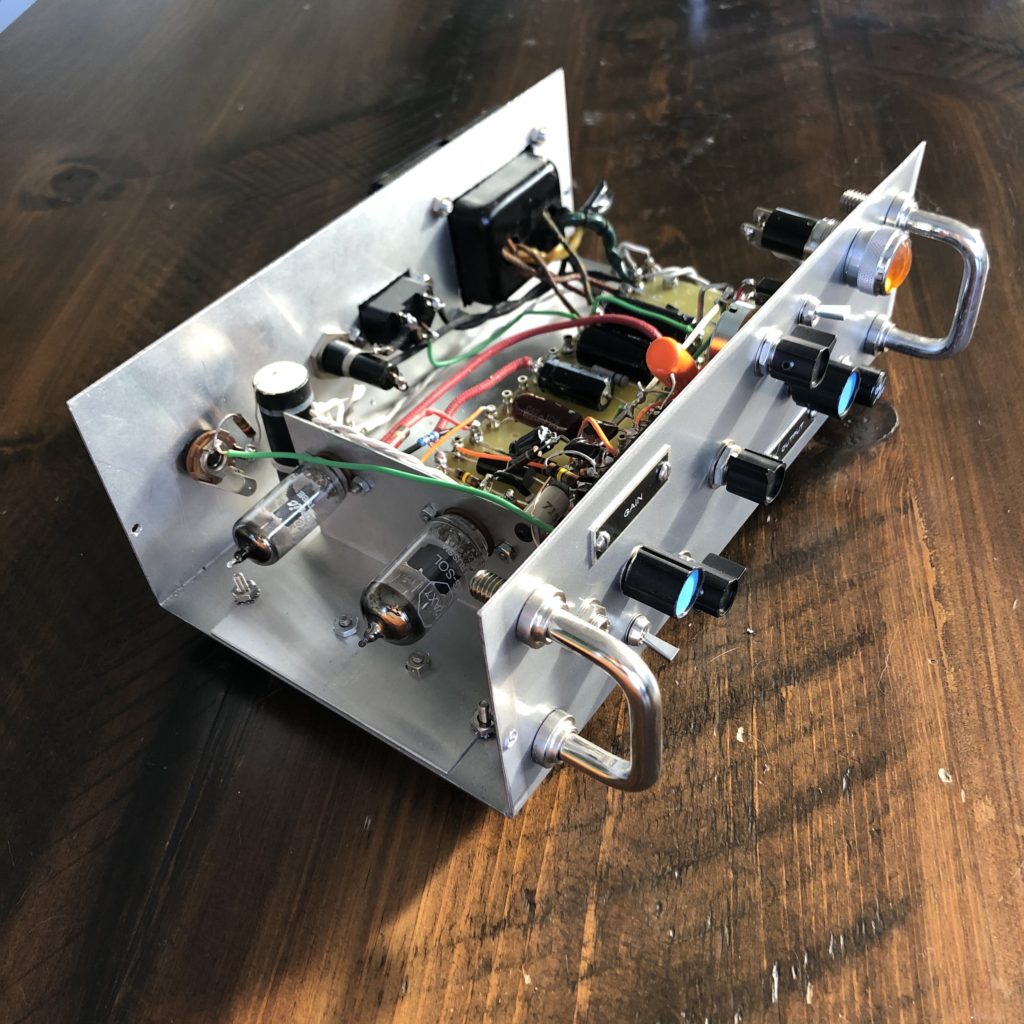
Above: the unit with the top cover removed. You can see the sub chassis with the 12AX7 and the 6C4 output driver; a huge Aerovox output cap; and the rugged fiberglass turret-board point-to-point construction.
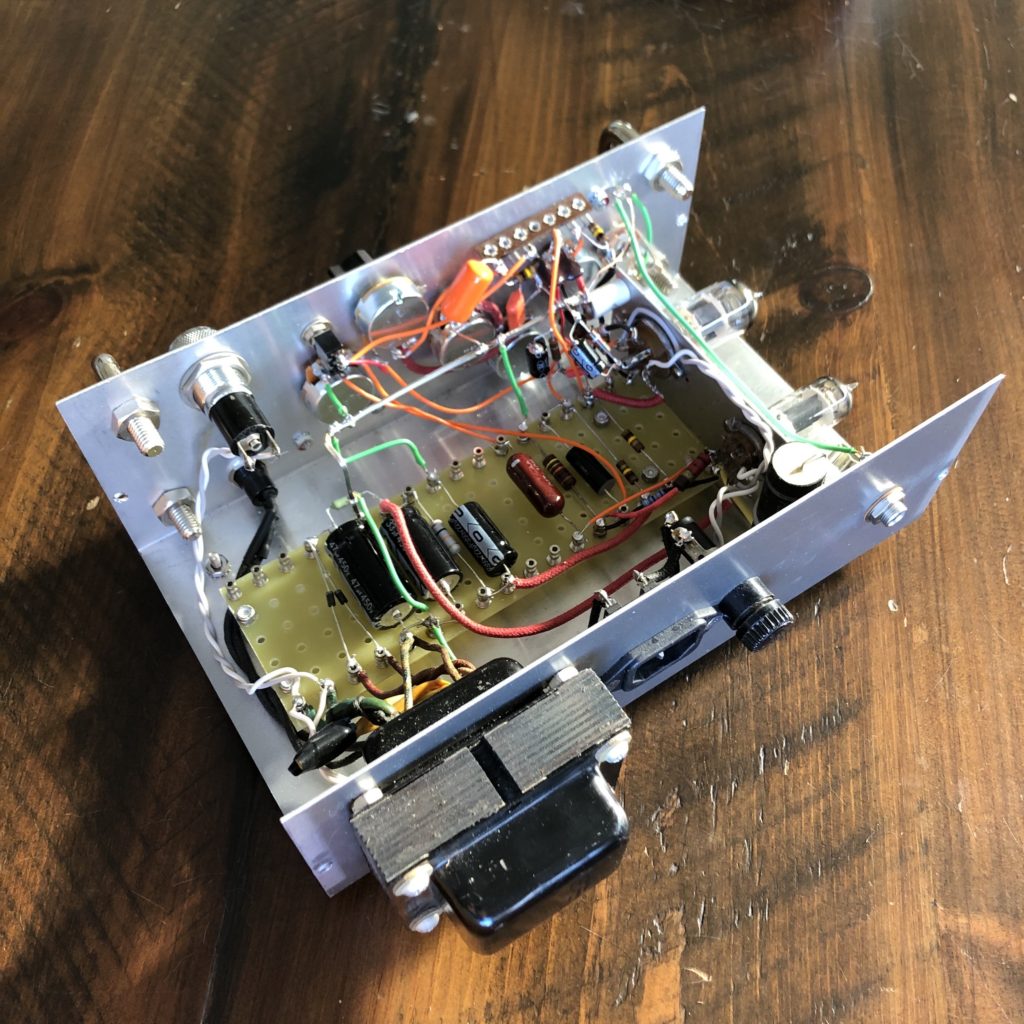
Above: another internal view. All of the hardware bits are DakaWare, API, and Smith NOS parts from the 60s and 70s, all from my inventory. Signal wiring (orange) is stranded silver 22ga wire and the ground wire (green) is 18ga solid copper.

How does it sound? With bass guitar its absolutely magical- every classic electric bass sound is just there at your fingertips; very inspiring to play thru. Really sounds like a ‘finished’ bass track with no additional processing. The whole package is compact enough to fit in many gig bags. As for the name? “Super” as the circuit owes much to my beloved Fender Super Reverbs, and “Hugh” as an homage to one of my all-time favorite session greats Hugh McCracken.
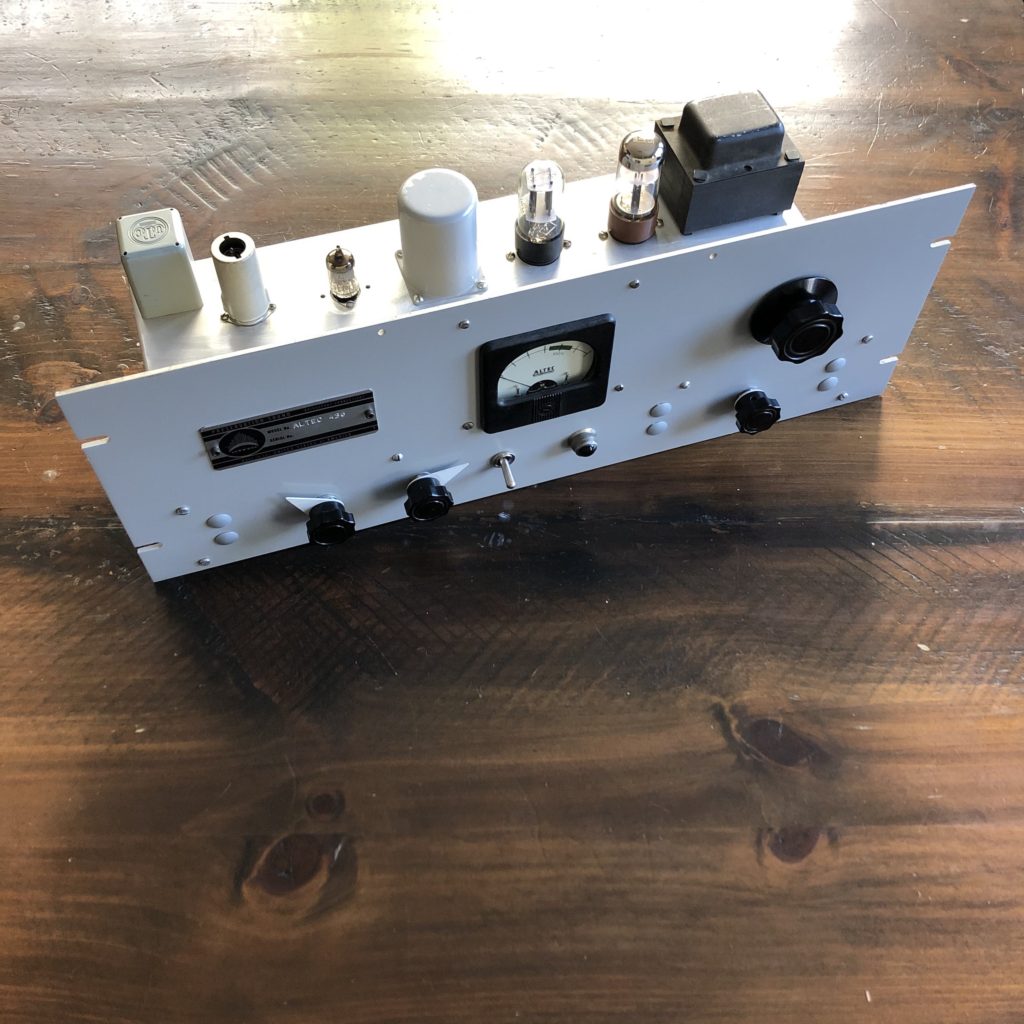
I’ve serviced and modified many Altec 43X-series compressors over the years, but I think this may be only the 2nd one I’ve built entirely from scratch. Styled more like a Federal AM864, this unit incorporates many of the tweaks and modifications that I have come to like in these machines. Here are some images of the build.
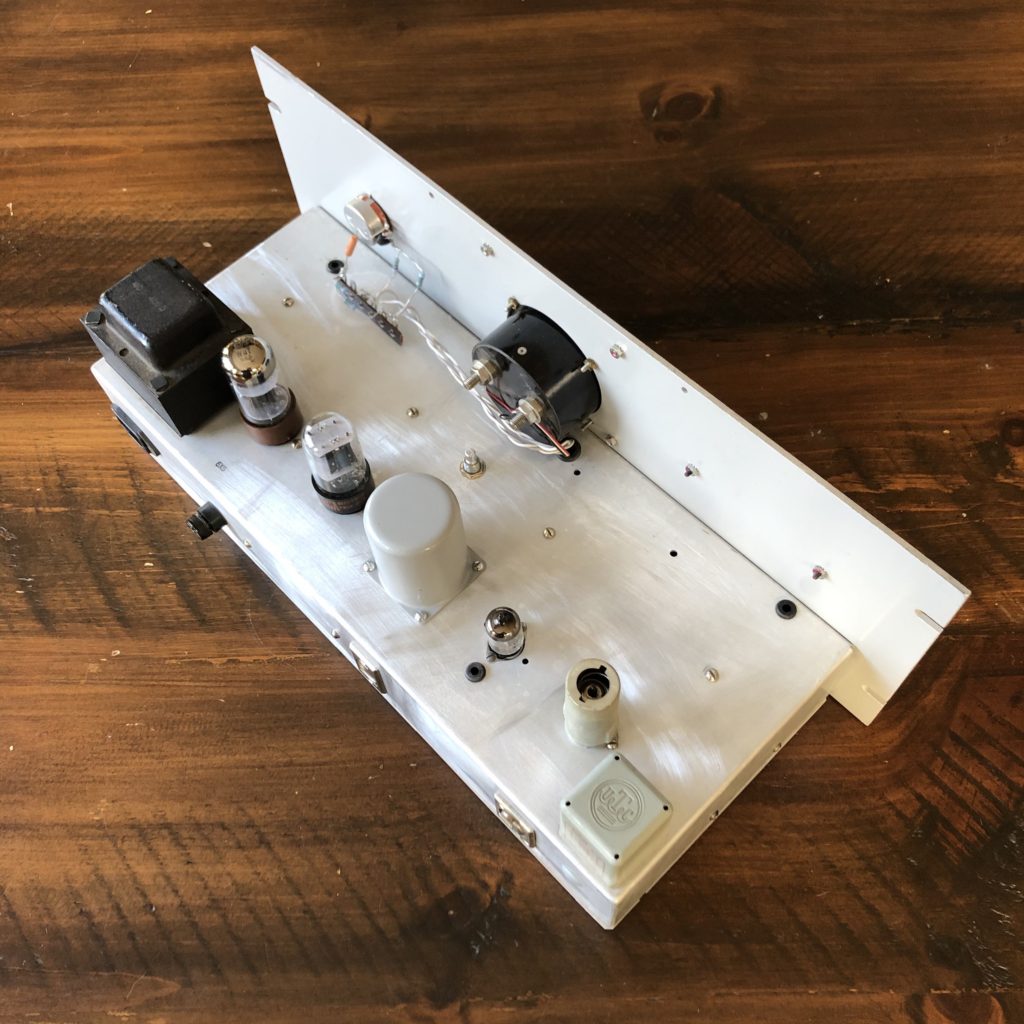
Couple of things to point out in the photo above. Note the larger “Octal” tubes (6X5 rectifier and 6SN7 output amplifier) on the left side. I like octal tubes, as the larger sockets are easier to work with, so space-permitting I tend to use them. The original 43X used a solid-sate rectifier (with a voltage doubler) but I used a more conventional full-wave supply with a rectifier tube since it suited the look better. The 6SN7 output tube was a nice choice as there are so many variations of this tube available. It’s a direct sub for the 6CG7 in the original Altec.
Also note: behind the meter is a ‘meter null adjust’ pot. I can’t recall how this was handled on the original Altecs, but this mod is a common one shown on many internet schematics of the 436. Also note the large pot to the left of the meter. This is the Gates Sta Level output trim control (-6 to -14db cut) that I detailed on this site years ago. A worthy and necessary addition!
You can also see the enormous output transformer in the center: a massive potted unit built for Daven, likely by UTC. originally built for hi-end test gear, it is ultra hi fi and handles more level than this thing will ever see.
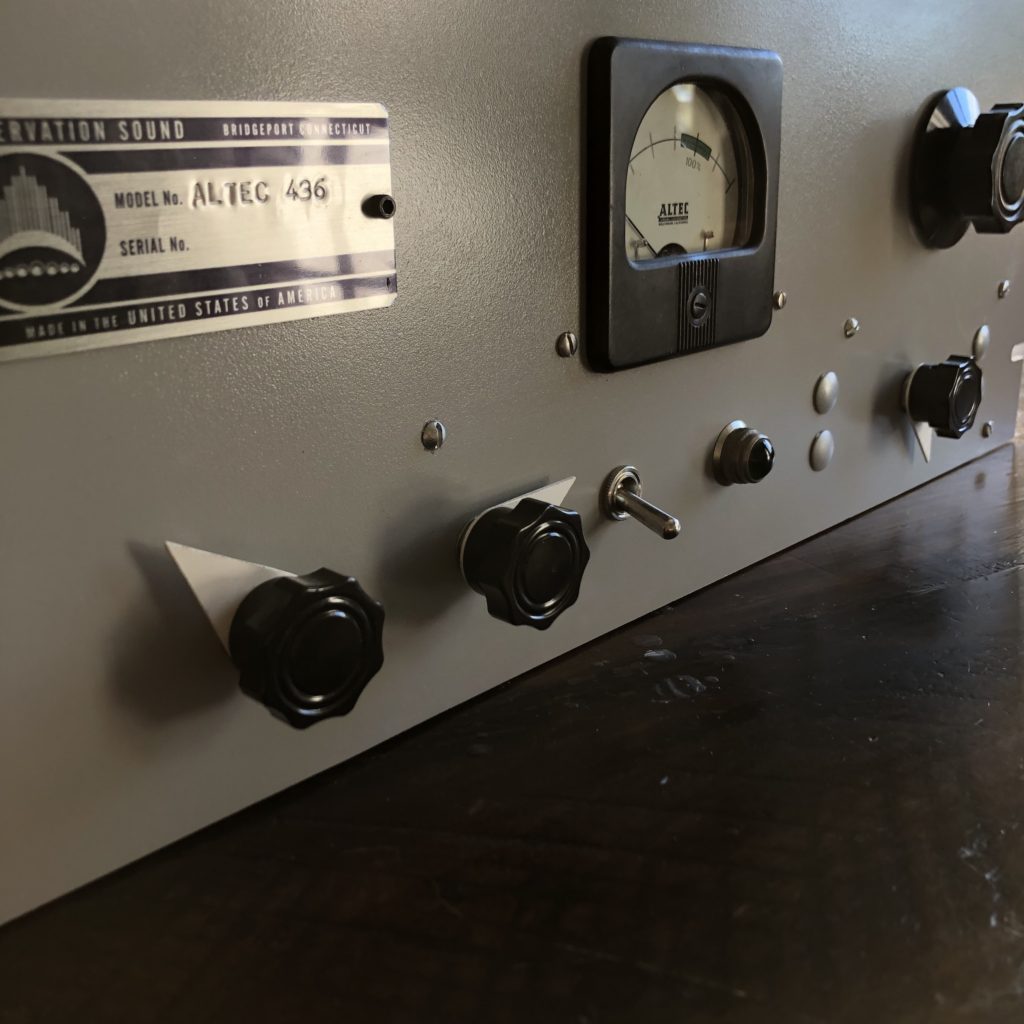
Above: some detail of the meter. I was motivated to build this thing solely because I found that original Altec panel meter at a hamfest for a buck. Seemed like it needed a 2nd life… Also check out that finish on the panel! That’s about 6 layers of paint and 3 layers of clearcoat, sanded between each coat. The knobs are all NOS 1960s DakaWare, acquired from Park Distributors in BPT CT (RIP).
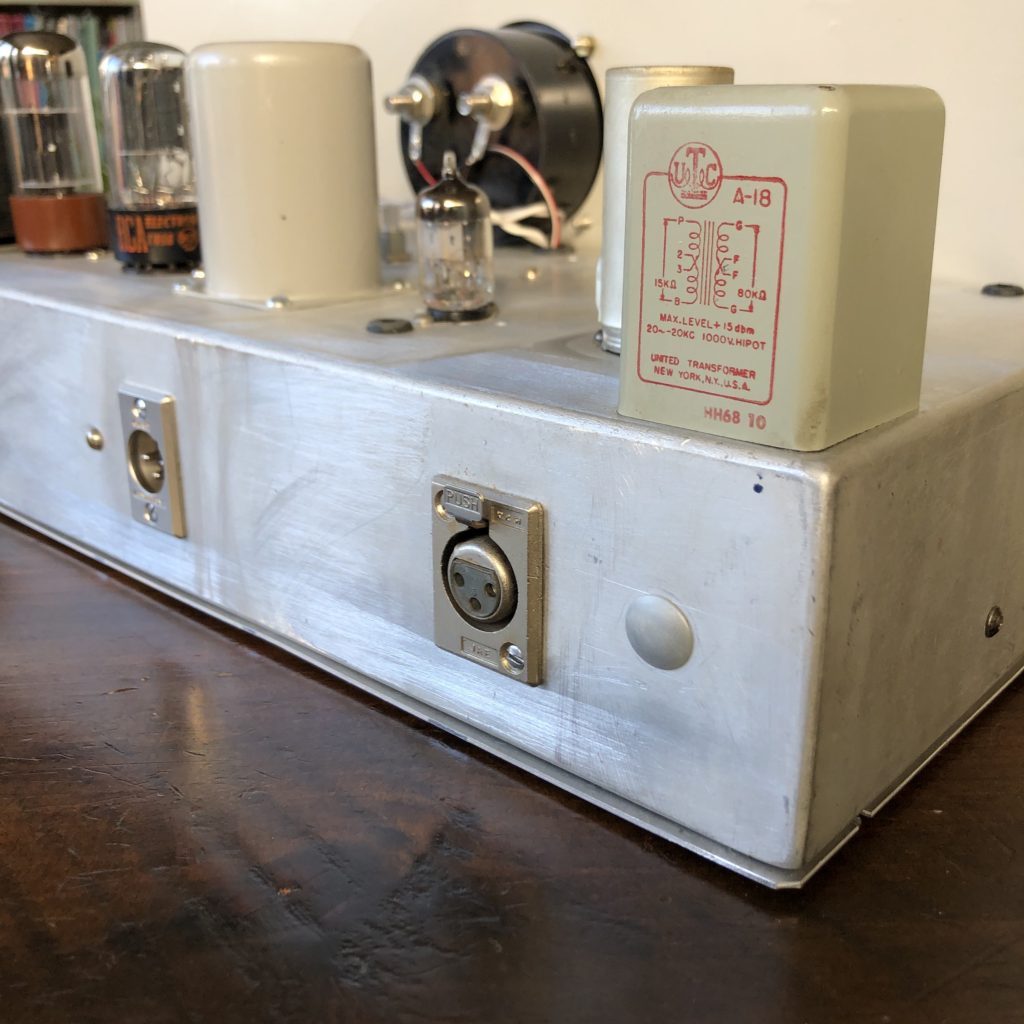
Above: the UTC A18 input transformer, which has similar specs / ratio to the Peerless plug-in unit that an original Altec would have been outfitted with.
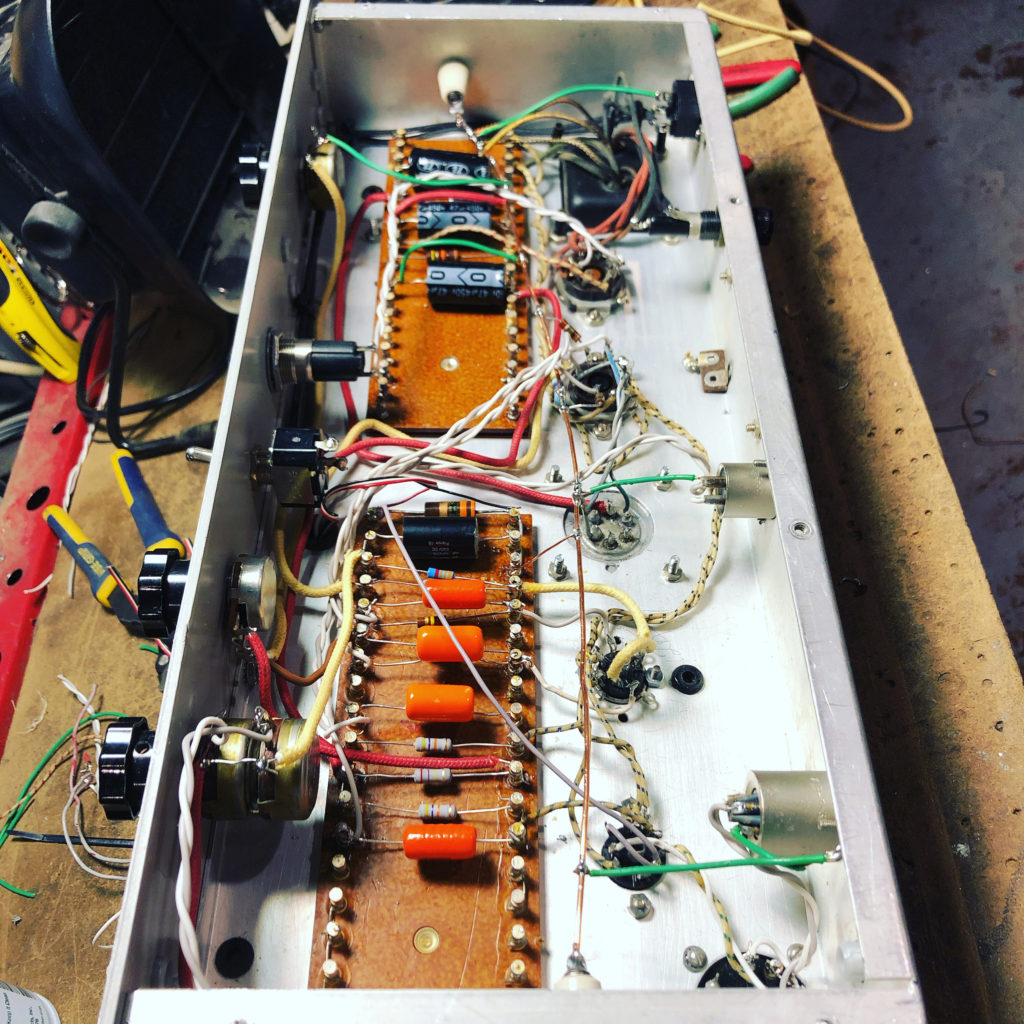
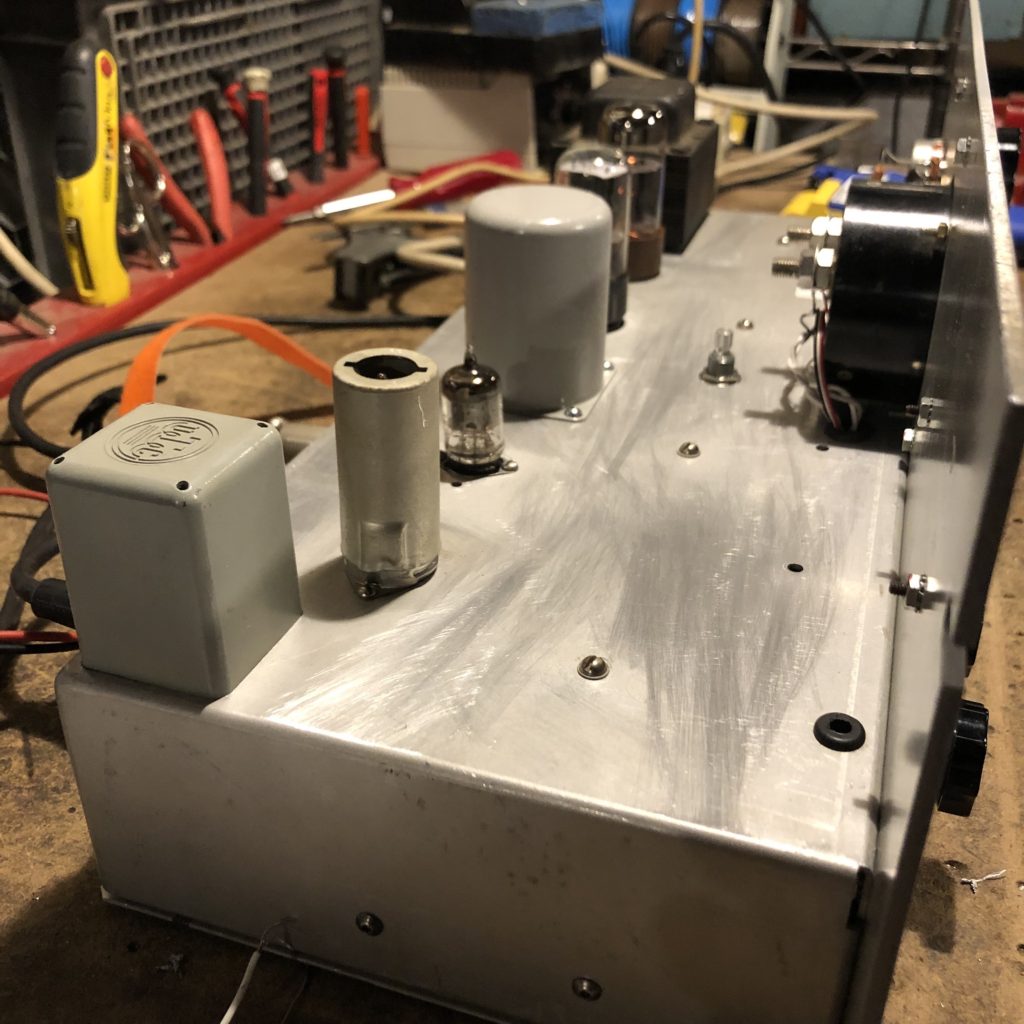
Above: the completed unit on the bench. The input pot is a really nice dual-gang 50K 1-watt sealed unit; I got several of these from Park before they closed. I cant imagine that any pot like this is available today for under $50. Good find. Running the length of the unit to the immediate right of the turret board is the heavy copper ground buss. Every ground in the machine connects here, and only here, and the ground buss meets the chassis at only one spot – the input jack. I swear by this construction technique. I’ve rewired a lot of old cheap tube guitar amps with this addition and the improvement in noise floor is remarkable.
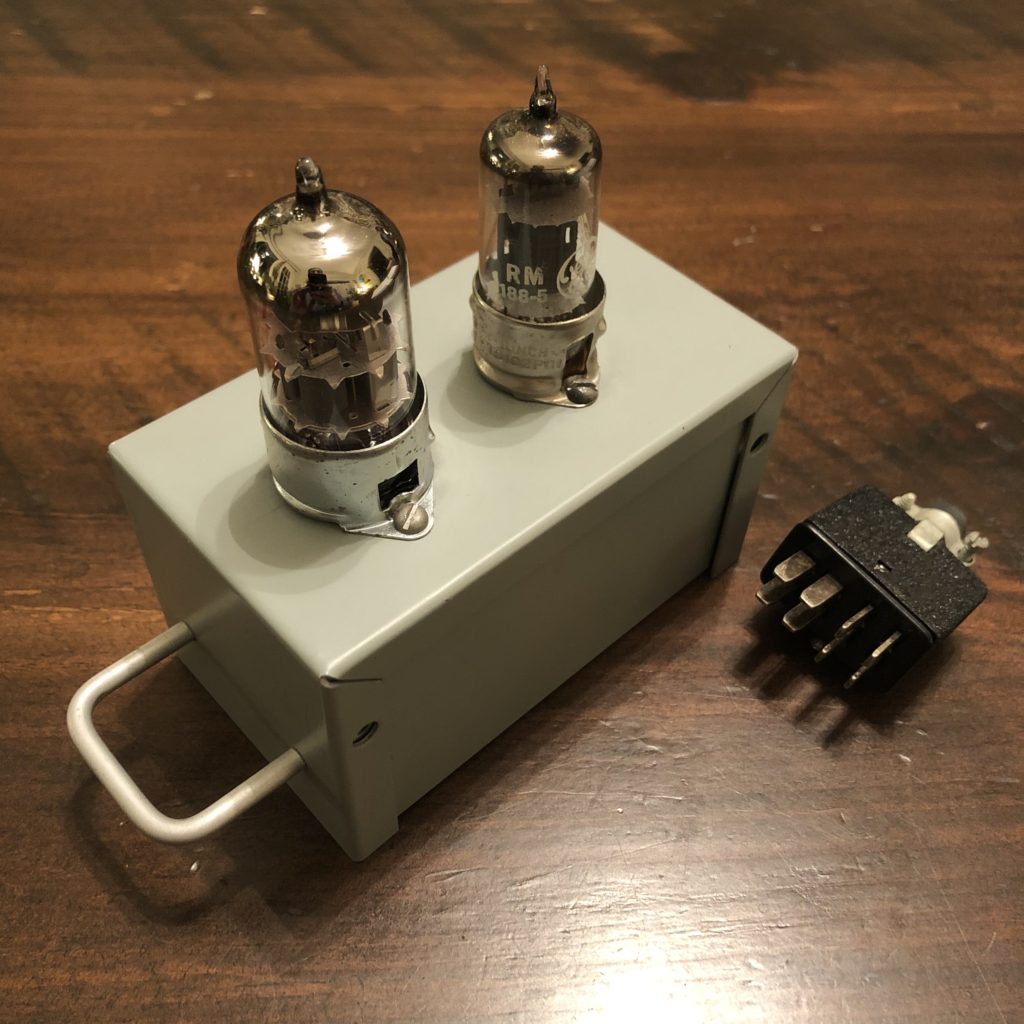
I’ve been developing an all-tube rotary-knob DJ console for the soundsystem at Berlinetta Brewing. One idea I decided to experiment with was building the 4 channels of phono pre amps as little plug-in modules, similar to theatre soundsystems of the 1940s and 50s. This would, in theory, allow me to make just 5 of the modules and have “zero downtime” if/when a channel failed. Anyhow, I made one as a demo, and man what a pain in the ass! The device you see above and below uses the classic RCA circuit from their receiving tube manual RC20 plus an additional 6c4 cathode-follower output stage, all built in a tiny grey Hammond box. All i/o and power (300vdc B+, 7vDC heaters) are on an 8-pin Jones for maximum “fake historical authenticity.” It worked out fine, sounds great, very low noise floor, but it’s just too fussy working in that tiny 4x2x2 inch box I will probably end up going with a different solution. Still an interesting possibility though…
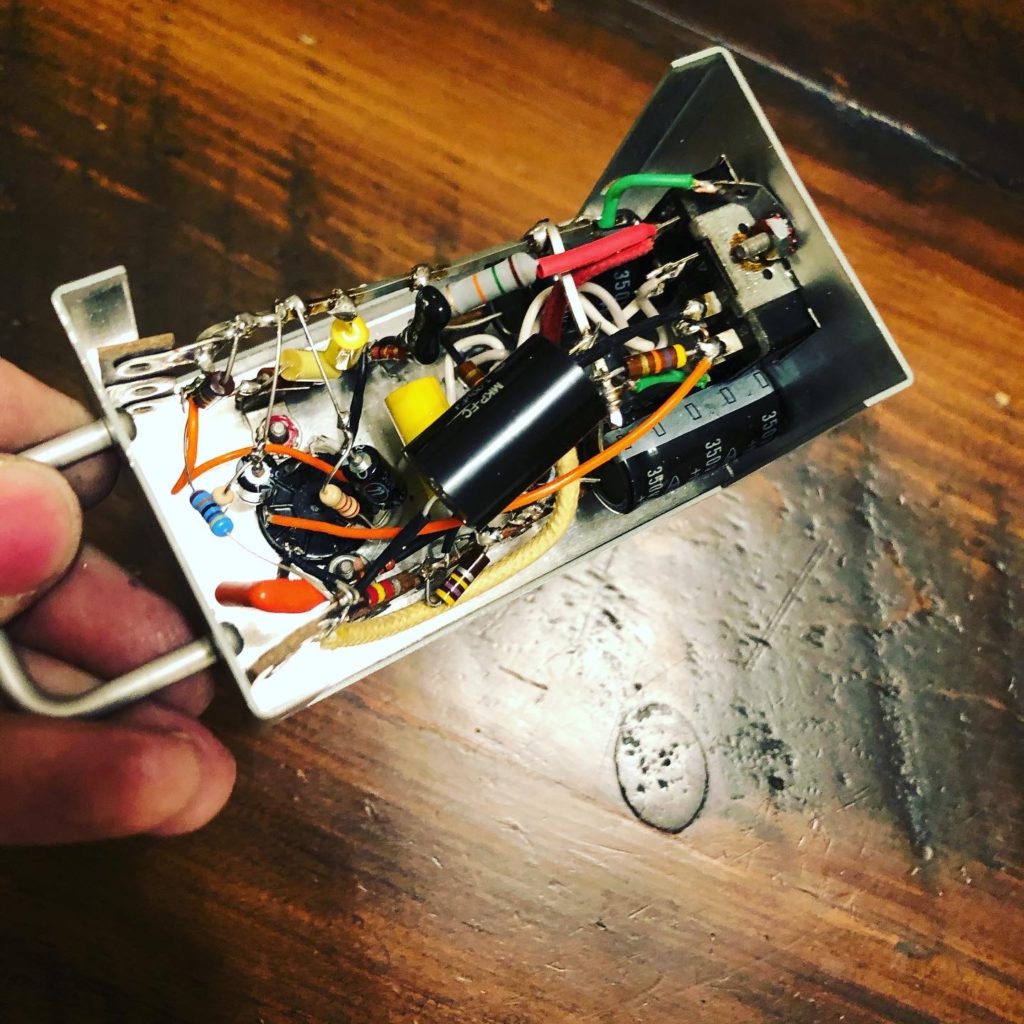
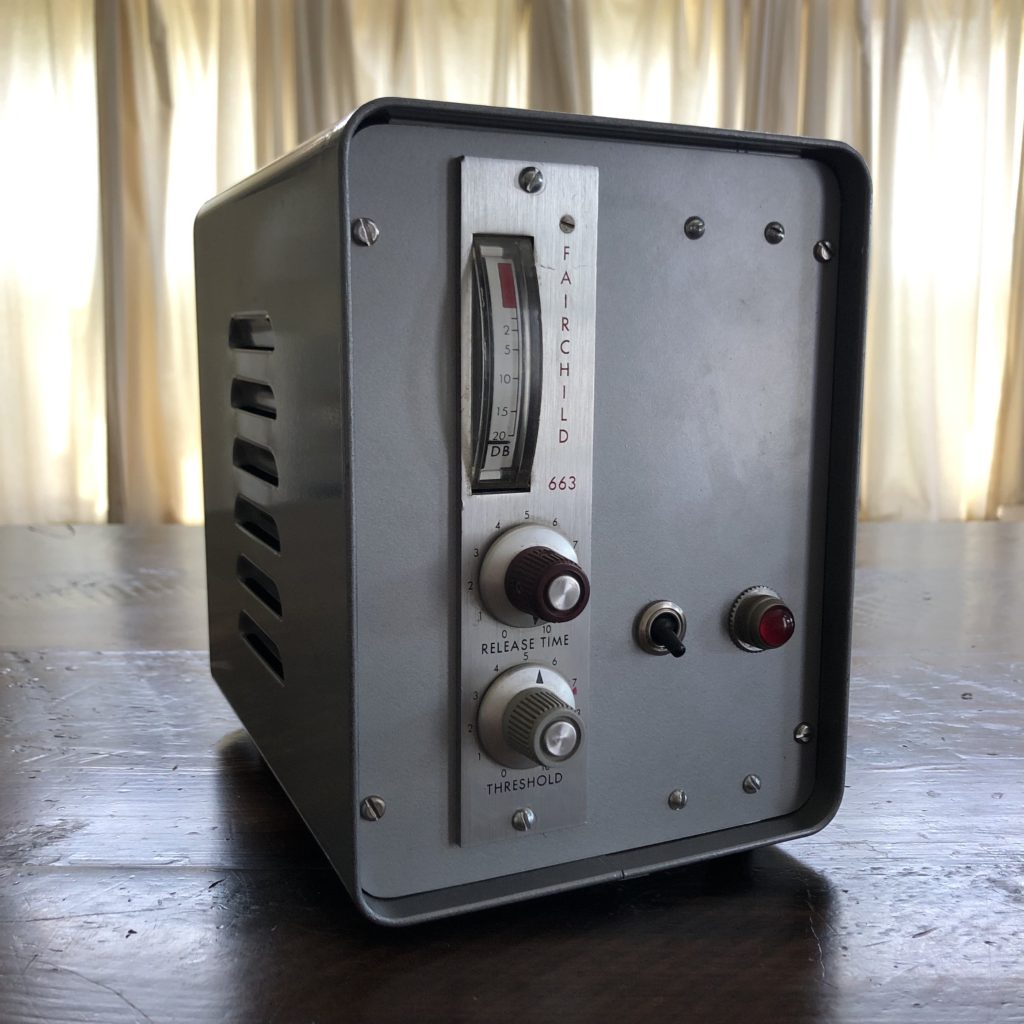
I was recently given this circa 1965 Fairchild model 663 optical compressor module. This unit was sold as part of their modular console range of the era. It requires 7V A/C power and it has a completely passive audio path! Seems incredible, but it’s true. Here’s what I did to ‘lunchbox it’ for standalone use in the studio. More details soon…
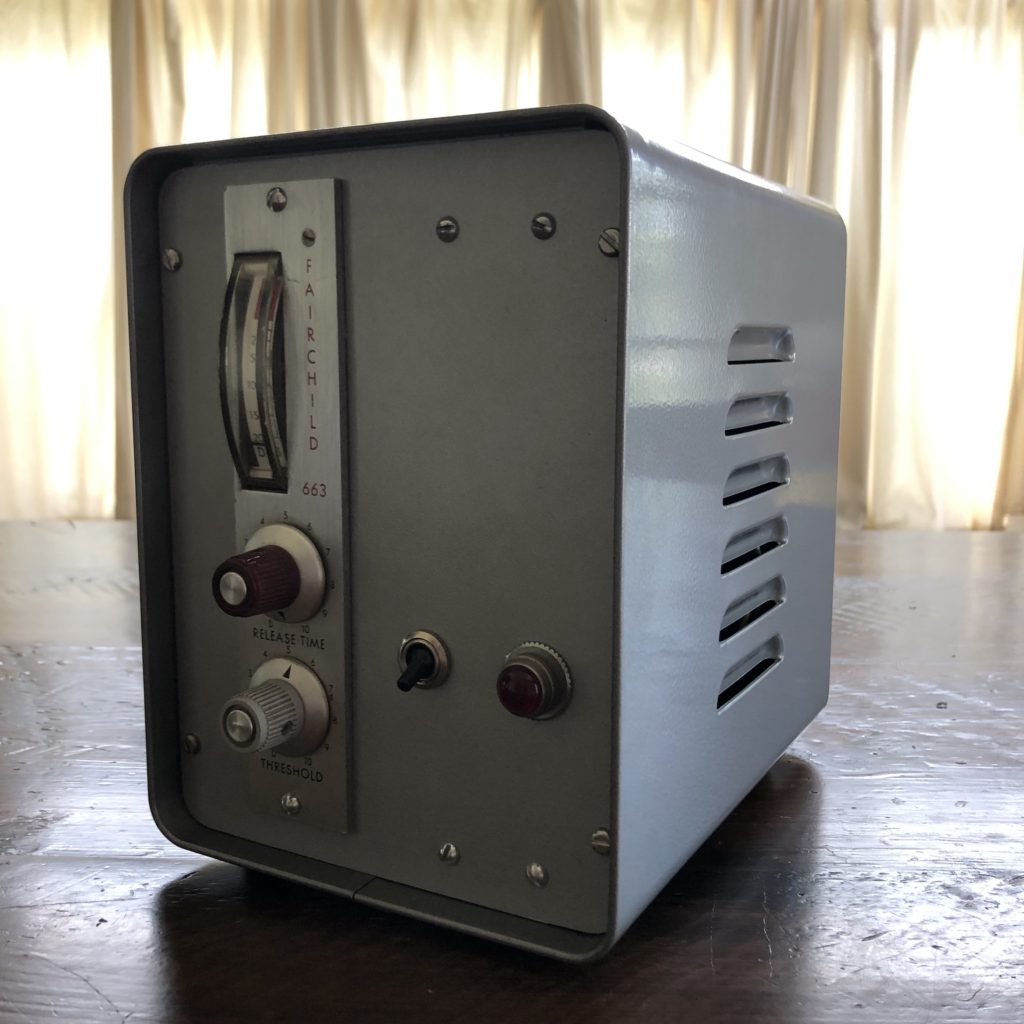
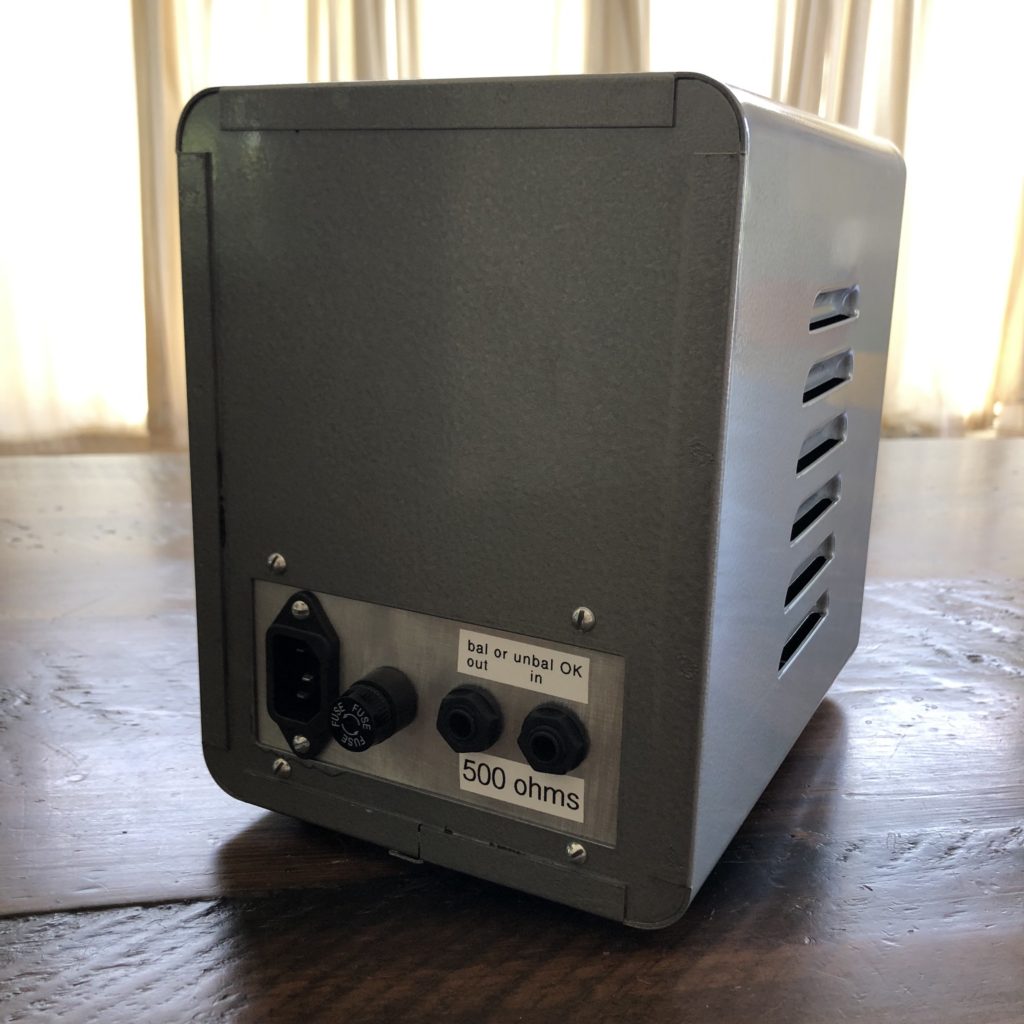
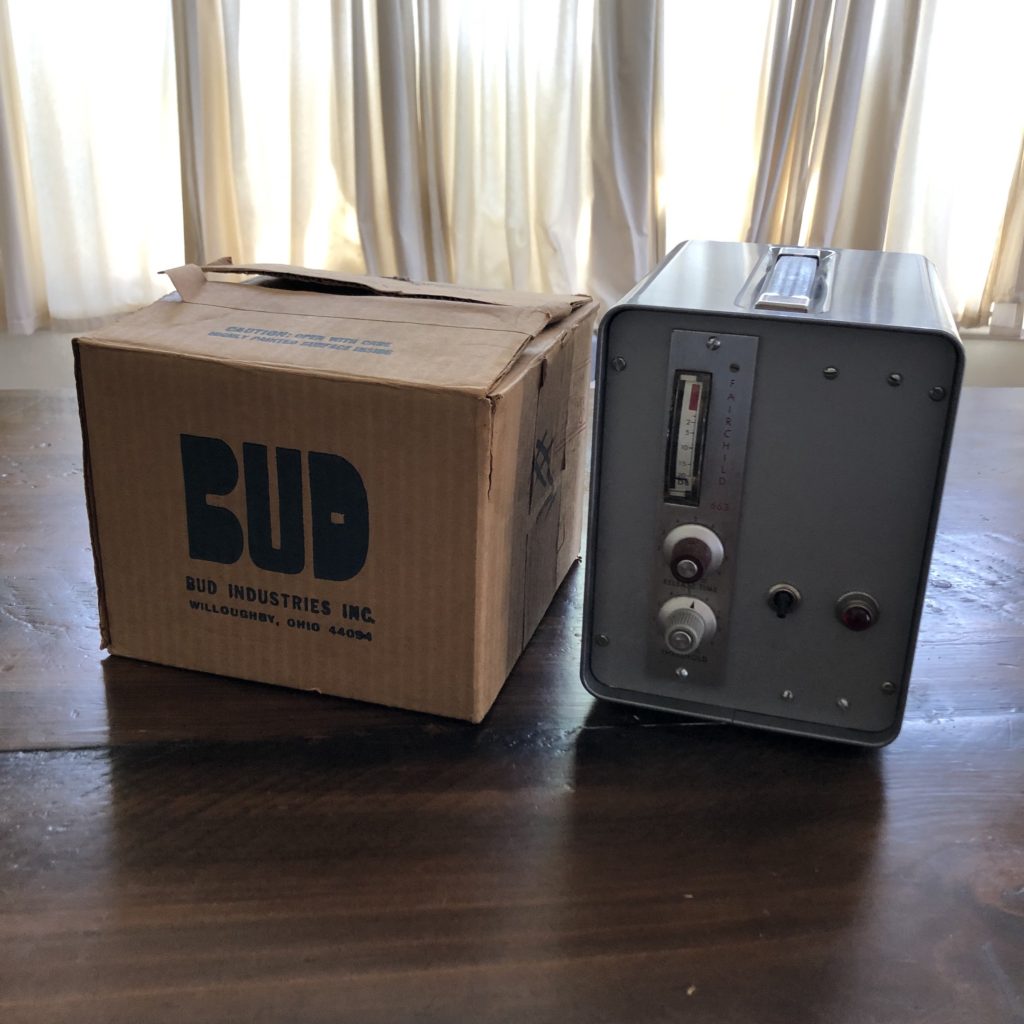
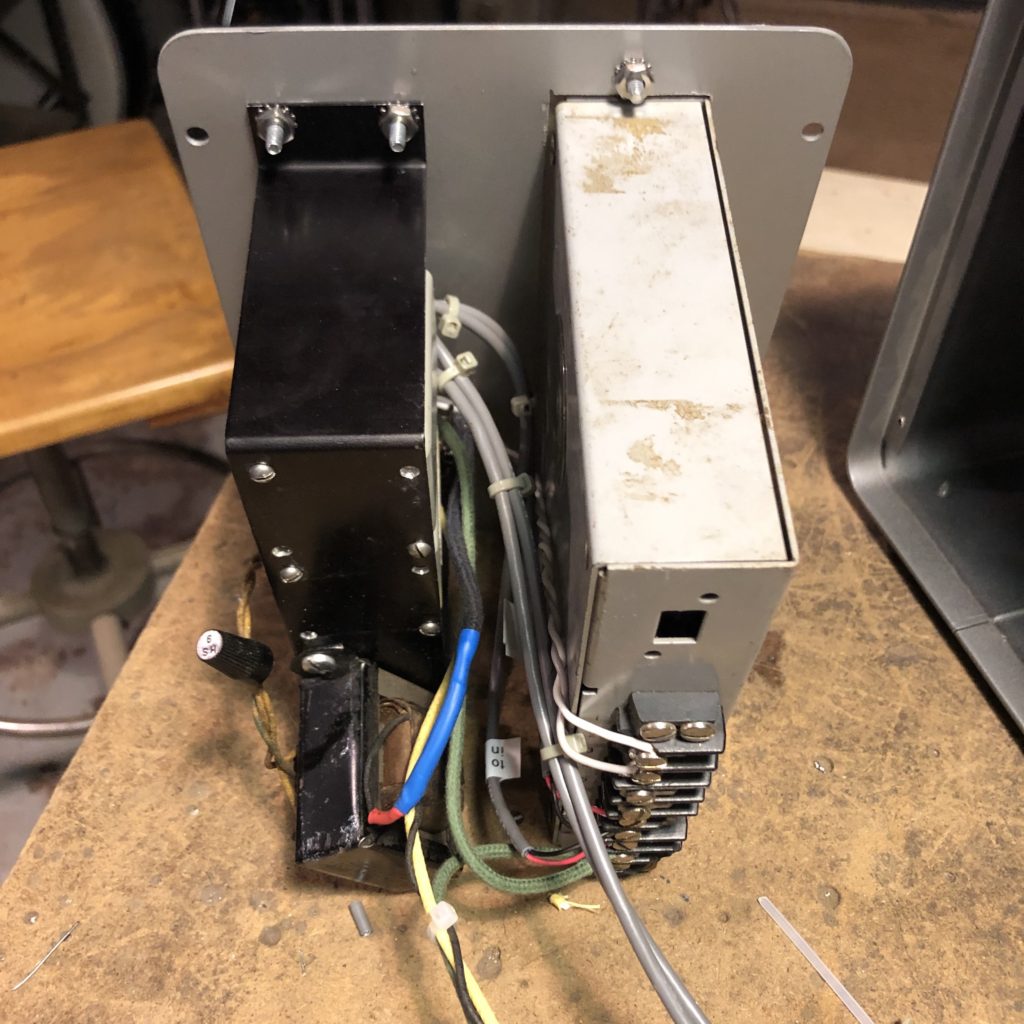
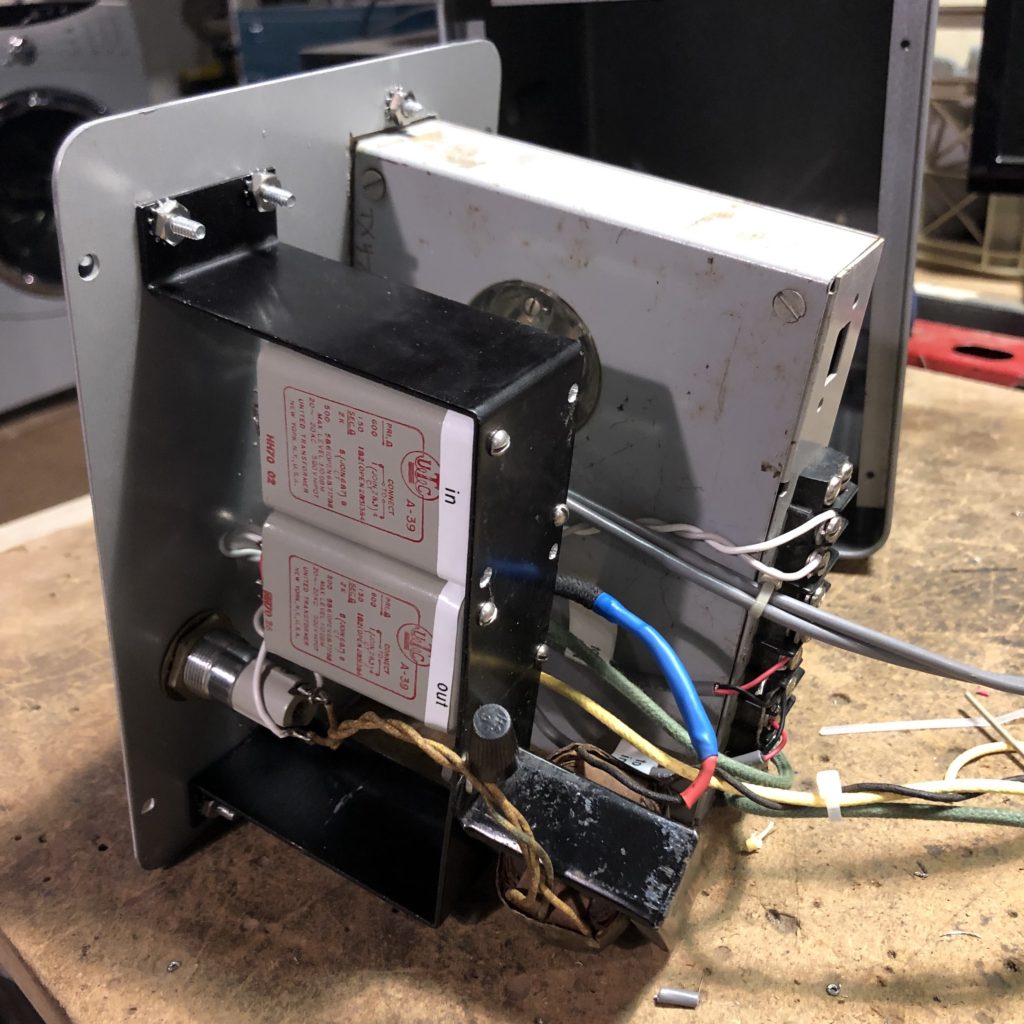
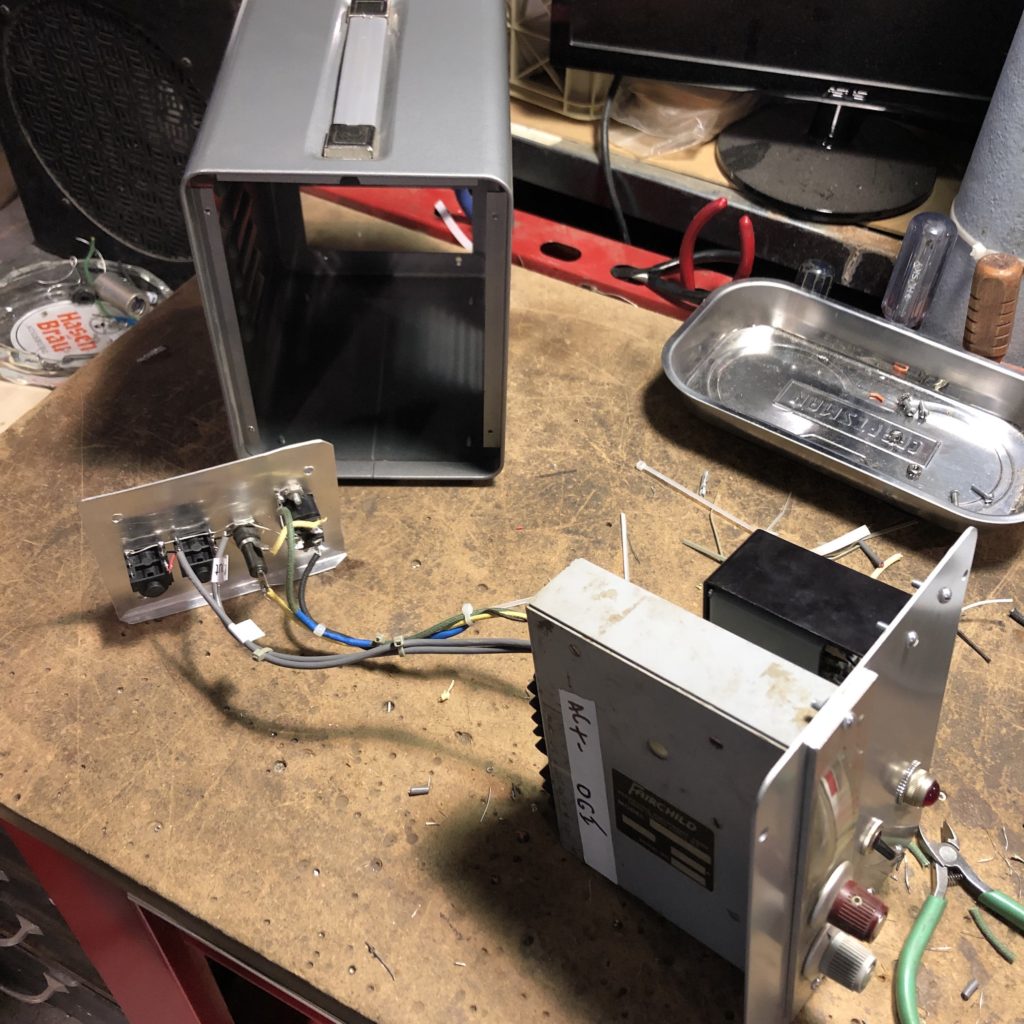
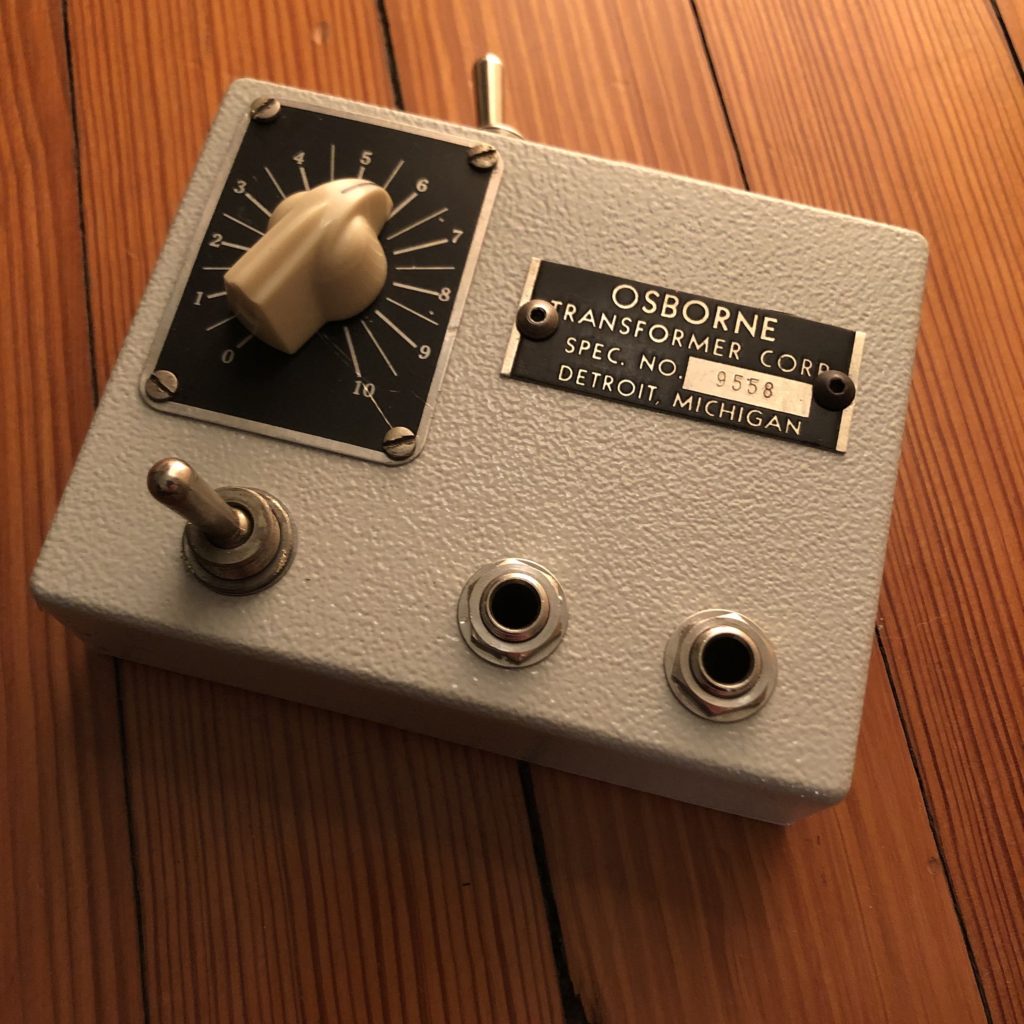
Last year I found myself with an excess of nice vintage 1:10 and 1:12 audio transformers, so I figured I would make some “Motown”-style passive DI boxes and see how they sounded. I built all of these using genuine 1960s era transformers, NOS Allen Bradley carbon-comp resistors, and NOS vintage hardware components in order to make something that ‘looked and felt’ like the sort of thing that a studio custom-shop would have built in that era. These aren’t copies of the Motown box – that piece used a particular model of transformer which I did not use, and I had my own aesthetic directions to pursue – but like the original units, they have that higher 1:12 ratio, variable defeatable pad, bi-directional operation (for use as a ‘re-amp’) and ground lift switch.
In the past I generally built my DIs with 1:5 or 1:8 ratios, so I was curious to see if the higher ratio gave a more open, detailed sound while still allowing for a sufficiently good signal-to-noise ratio. After building a half dozen of these things, I can say that yes they sound great. Here are a few examples of the units I built.
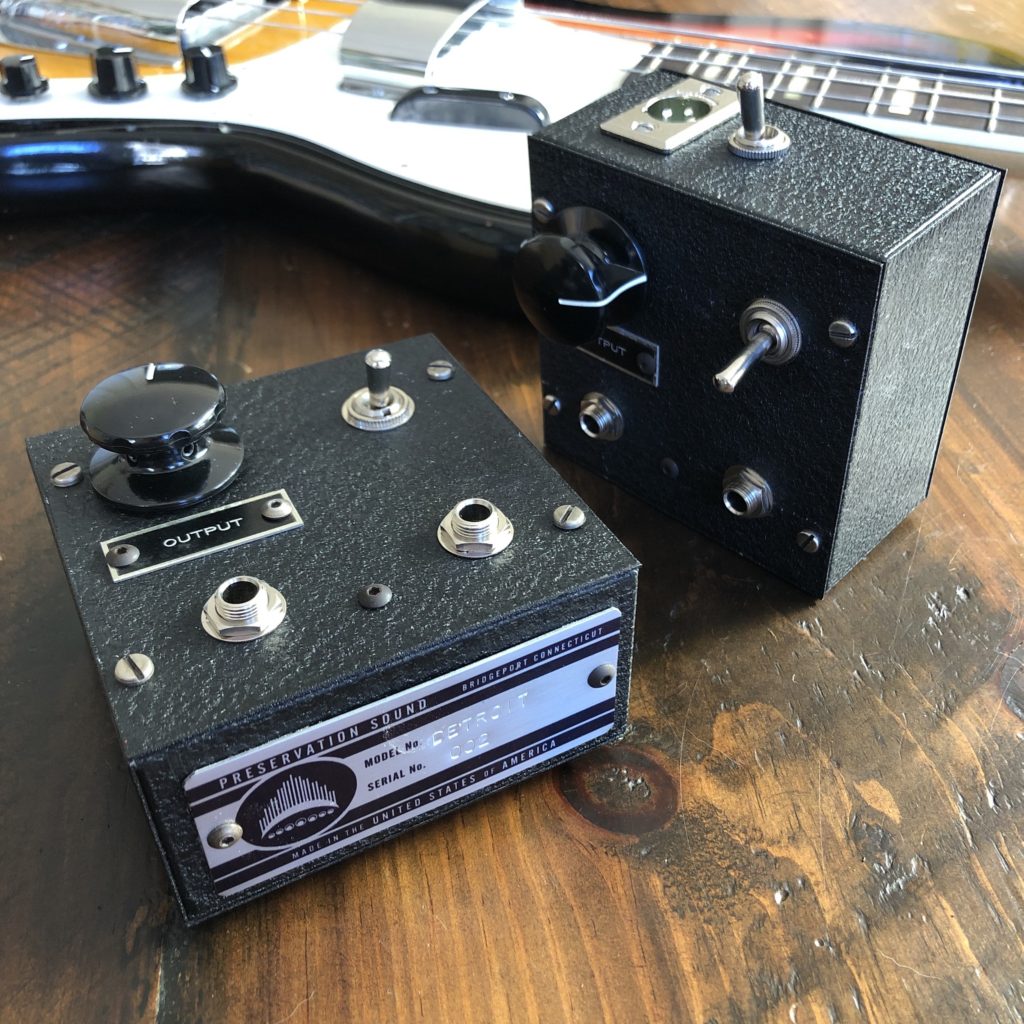
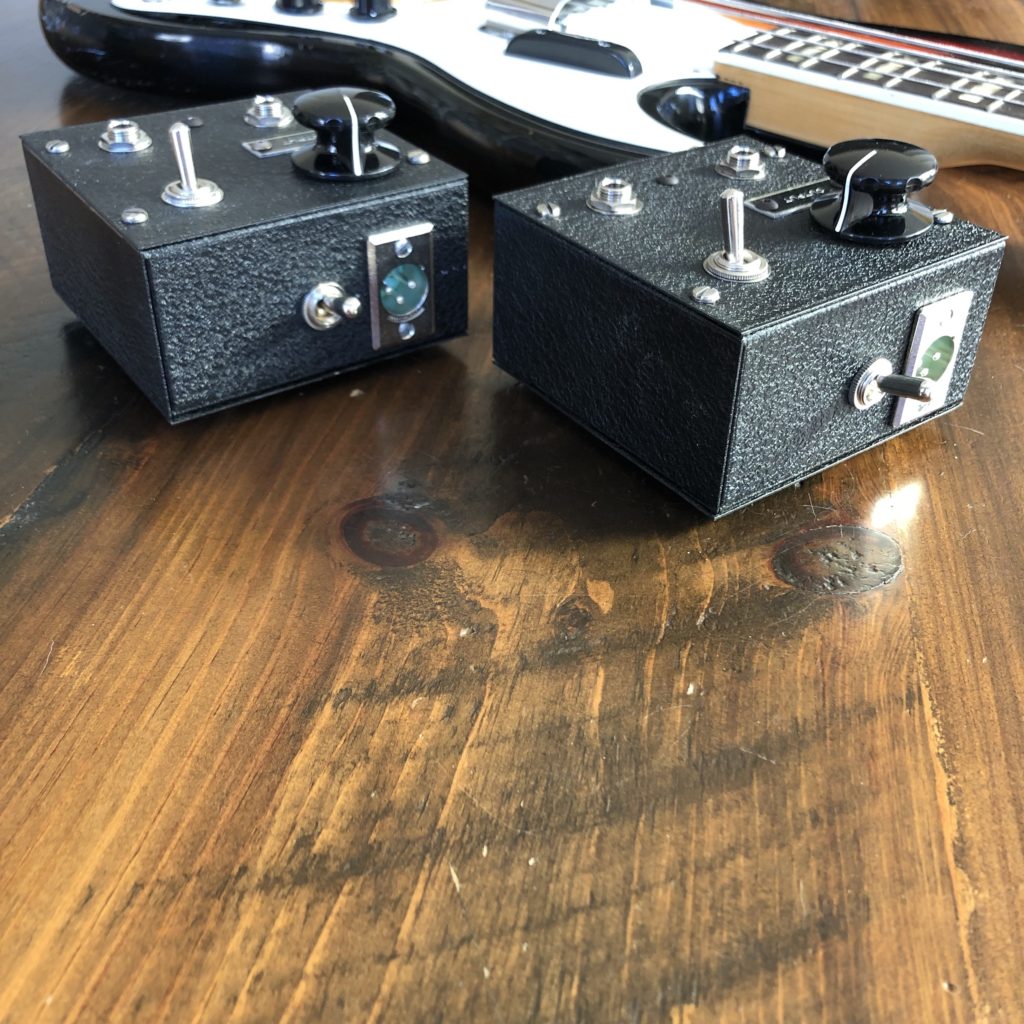
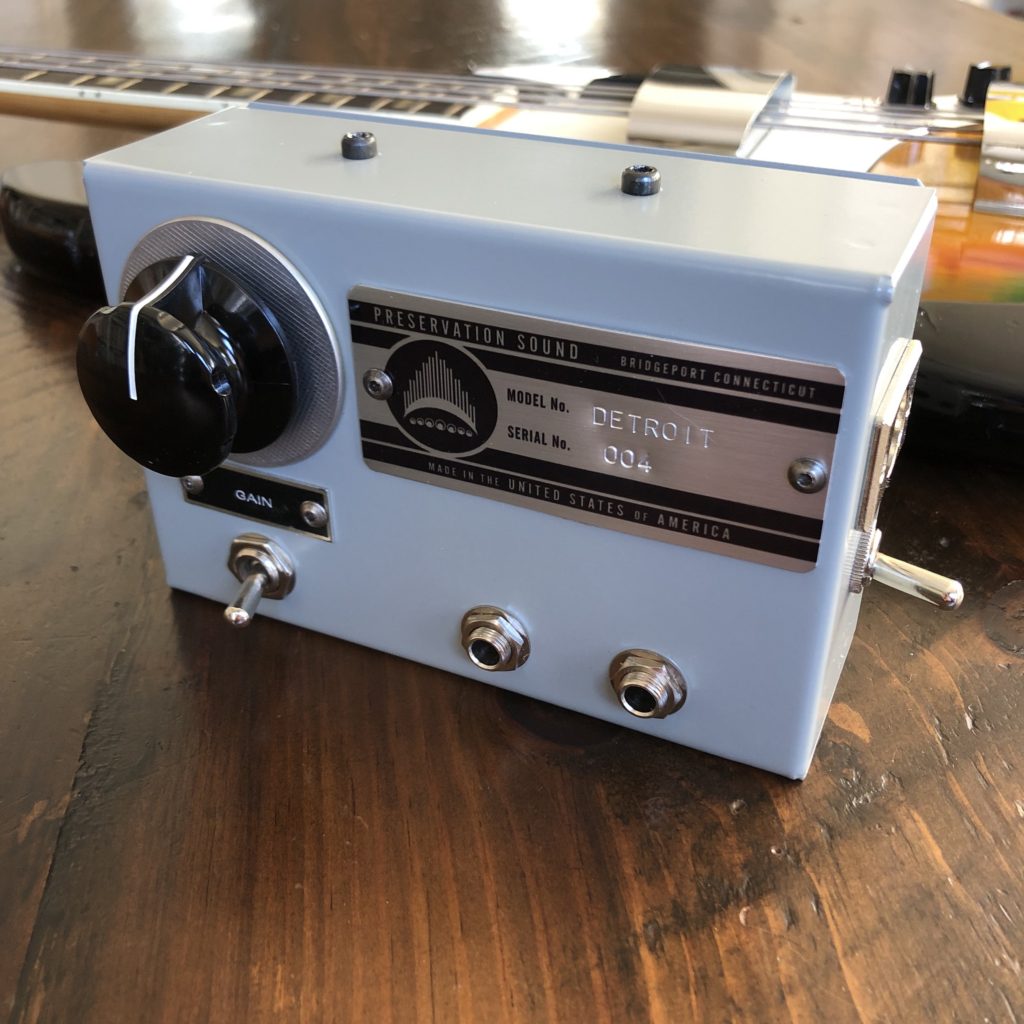
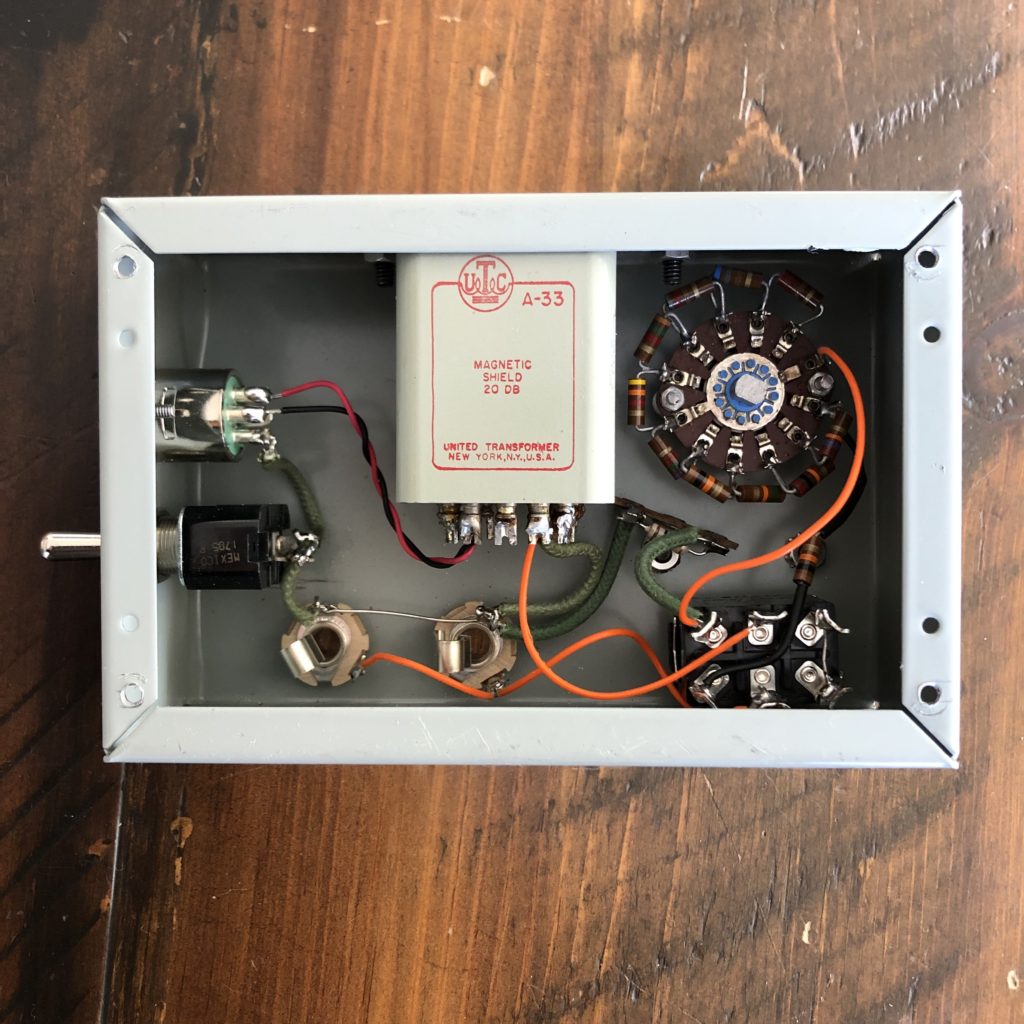
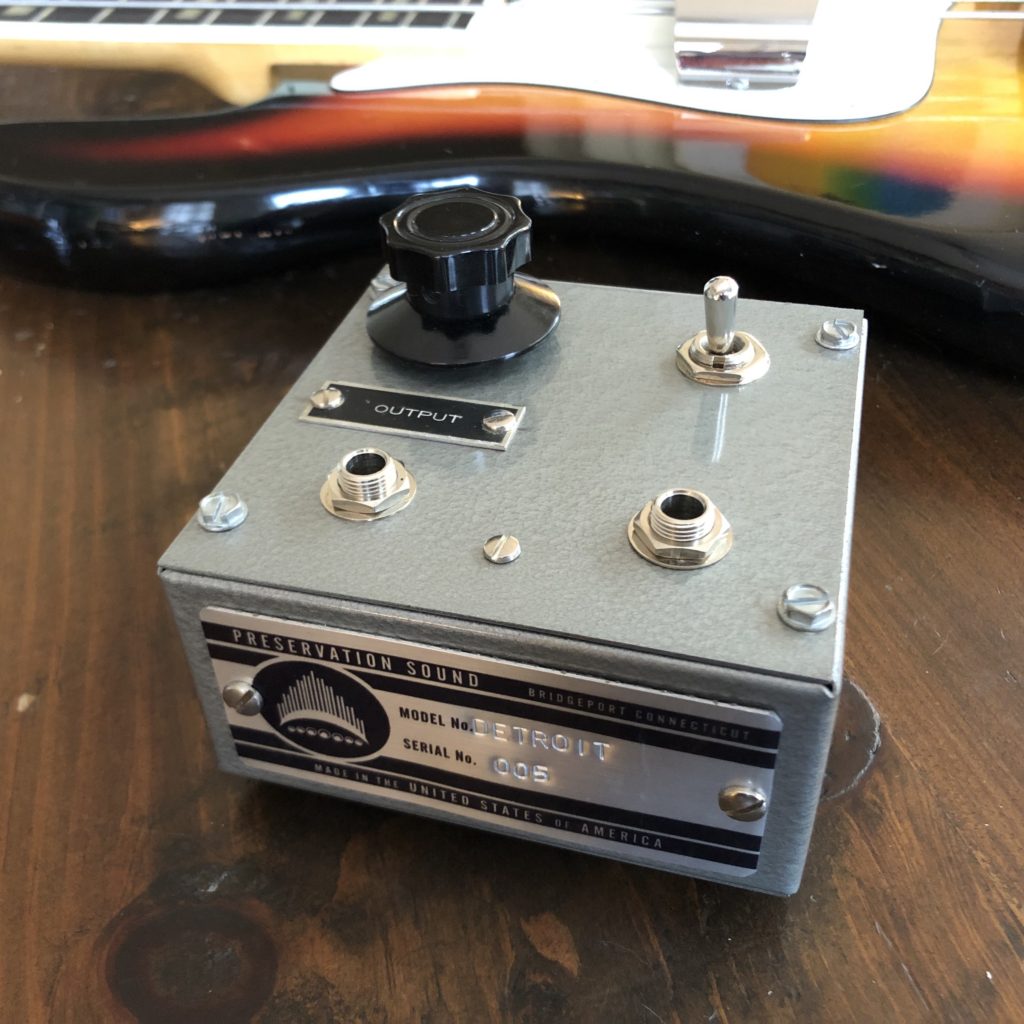
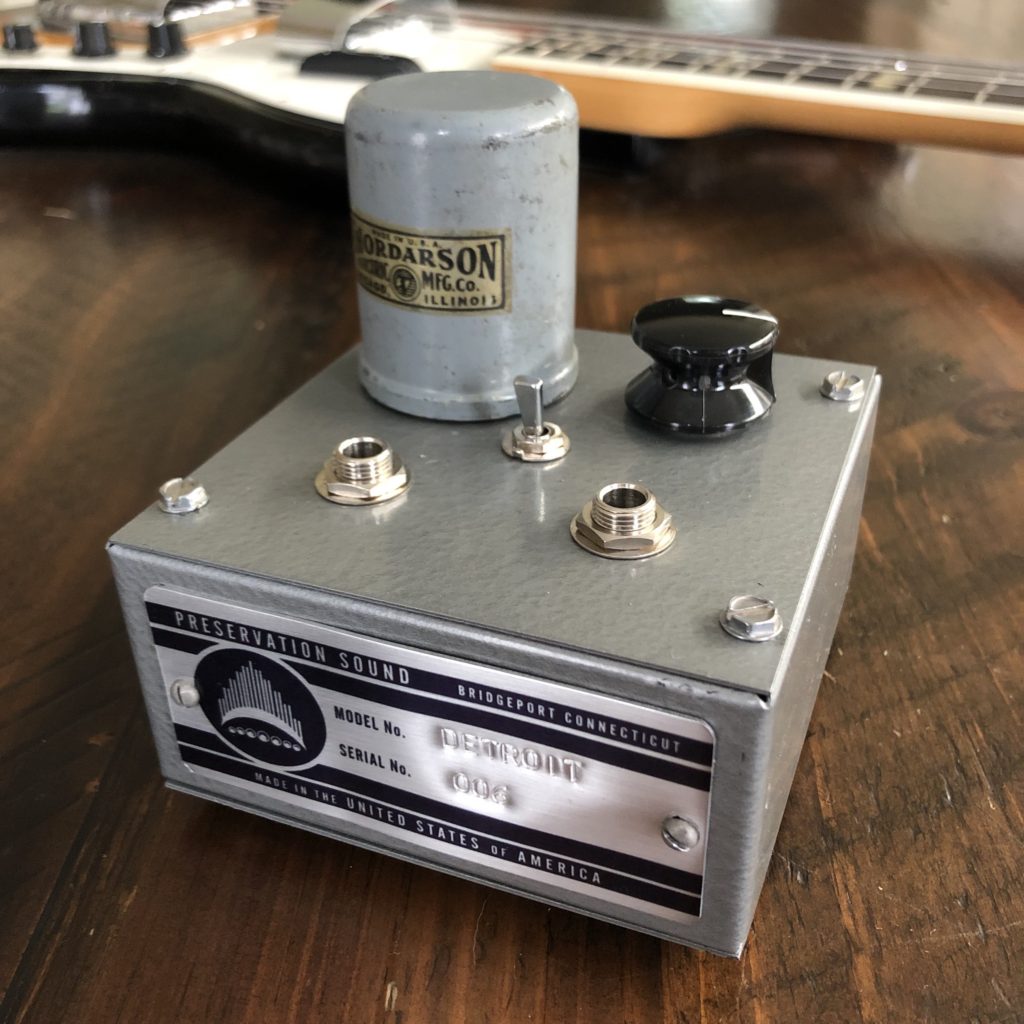
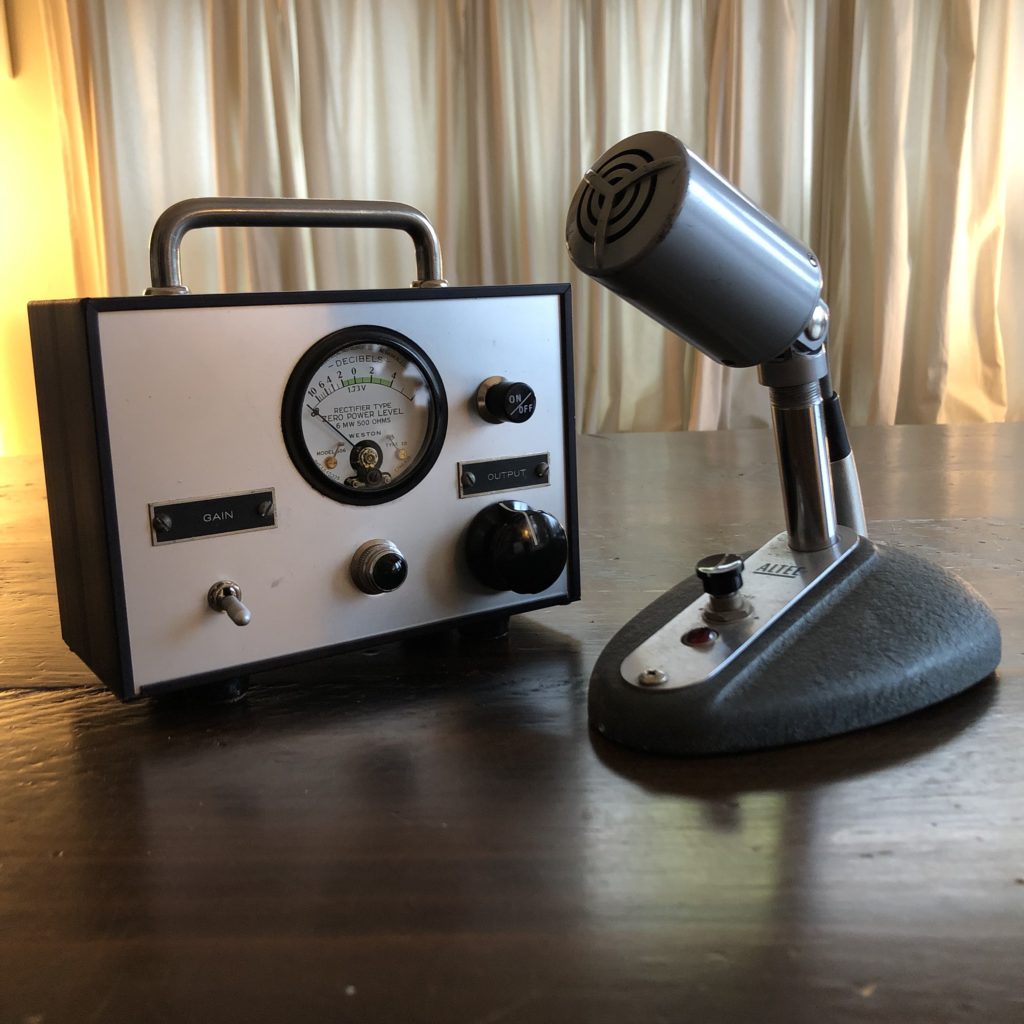
This is my first post using this intensely frustrating new WordPress “Blocks” authoring structure so it will brief/awkwardly formatted. Why TF they would change this platform so drastically after all these years is beyond me but I guess there is no shortage of bad ideas in the world. OK got that out of the way. I was recently reminded of the existence of (many, many, many) of these Altec 1588C microphone preamp modules.

(image source) The 1588C is an octal module with flexible DC powering requirements and offers around 35DB of gain into a 10ohm load. According to the spec sheet it is full-frequency. It has an input transformer and can pass the DC supply voltage as phantom power if wired as such. Years ago I had an Altec 1592 mono sound-reinforcement mixer that used these things; it sounded fine.
Anyhow, some post on Instagram reminded me that these things are out there; a quick eBay check revealed that they are very cheap (if you are patient); I bought three for around $30 shipped. Here’s the original data sheet.
It occurred to me that if these things really do perform as well as advertised, they COULD make a good basis for the custom mixing console i’ve been dreaming about for, oh, 15 years. But first: I had to know. I needed to build some thing to test the 1588’s and see if they really do perform well and sound good.
Following the advice offered in this online forum, I figured I would wire one up with a 1K pot strapped to the output, feeding a high-quality 600:600 transformer. The best thing I had around that would fit in the tiny chassis was a Jensen JT-11-FLCF. Here’s the specs on that piece:
Since everyone likes a vintage mechanical VU meter, I added one of those too, driven by a buffer amp from DIY–TUBES.com. I’ve bought dozens of these lil amp boards from them and they go together quickly and work great.
Here are some photos of the assembled unit so you can see how it all went together. The chassis is a (was a) NOS NIB “Versa-box” or something like that; it came from an ancient distro in my city. I don’t thing you can expect to find many of these left in the wild, but any old steel, aluminum, or plastic box should do. The RCA-style knob (SATO brand) and pushbutton power switch came from Akihabara in Tokyo; I’ve been unable to find an online source for them. The top handle is an old pull, probably ParMetal or the like, with a pair of beauty washers (AMAZON) to help the appearance. The ‘GAIN’ and “OUTPUT’ metal tags are from a huge hoard of these I bought from the estate of a Silent Key; I have no idea where to find these, but someone should start making these again! (i mentioned the idea to RedCo but they weren’t interested)
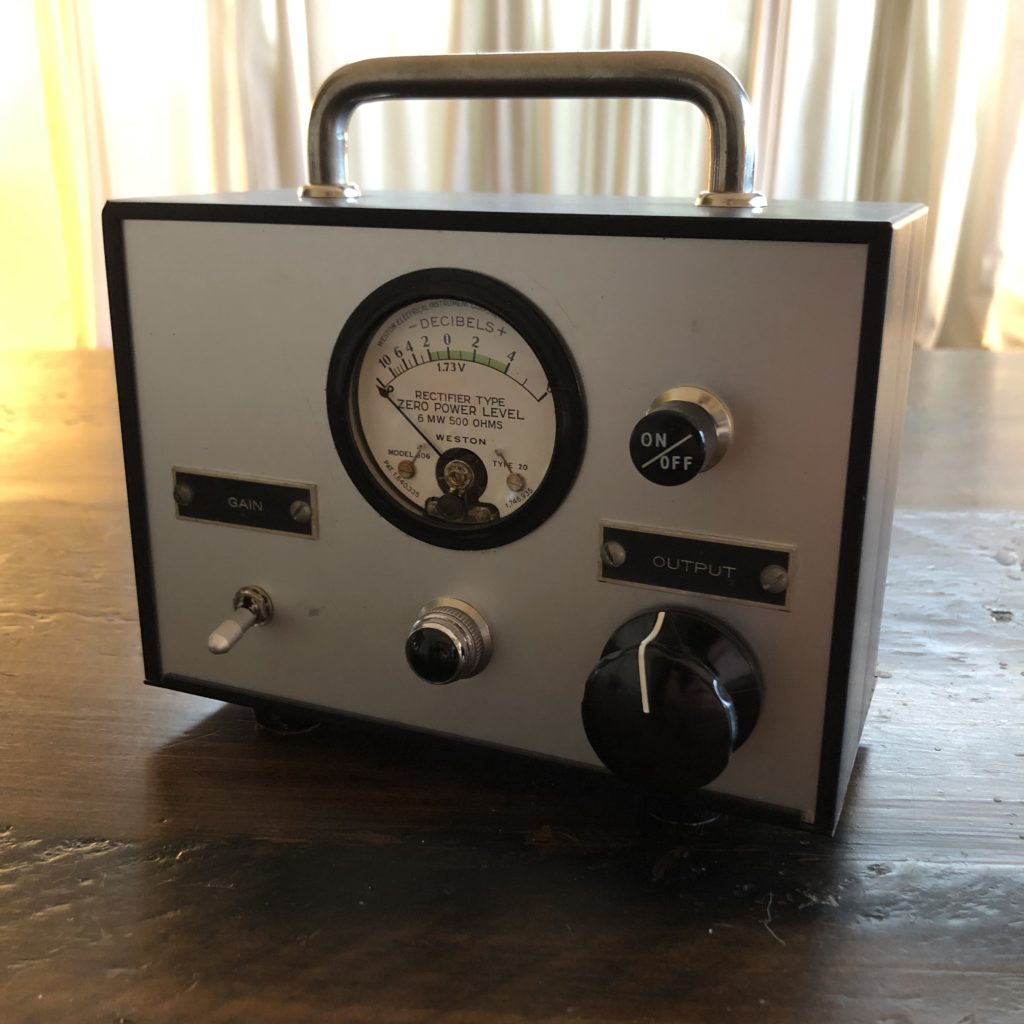
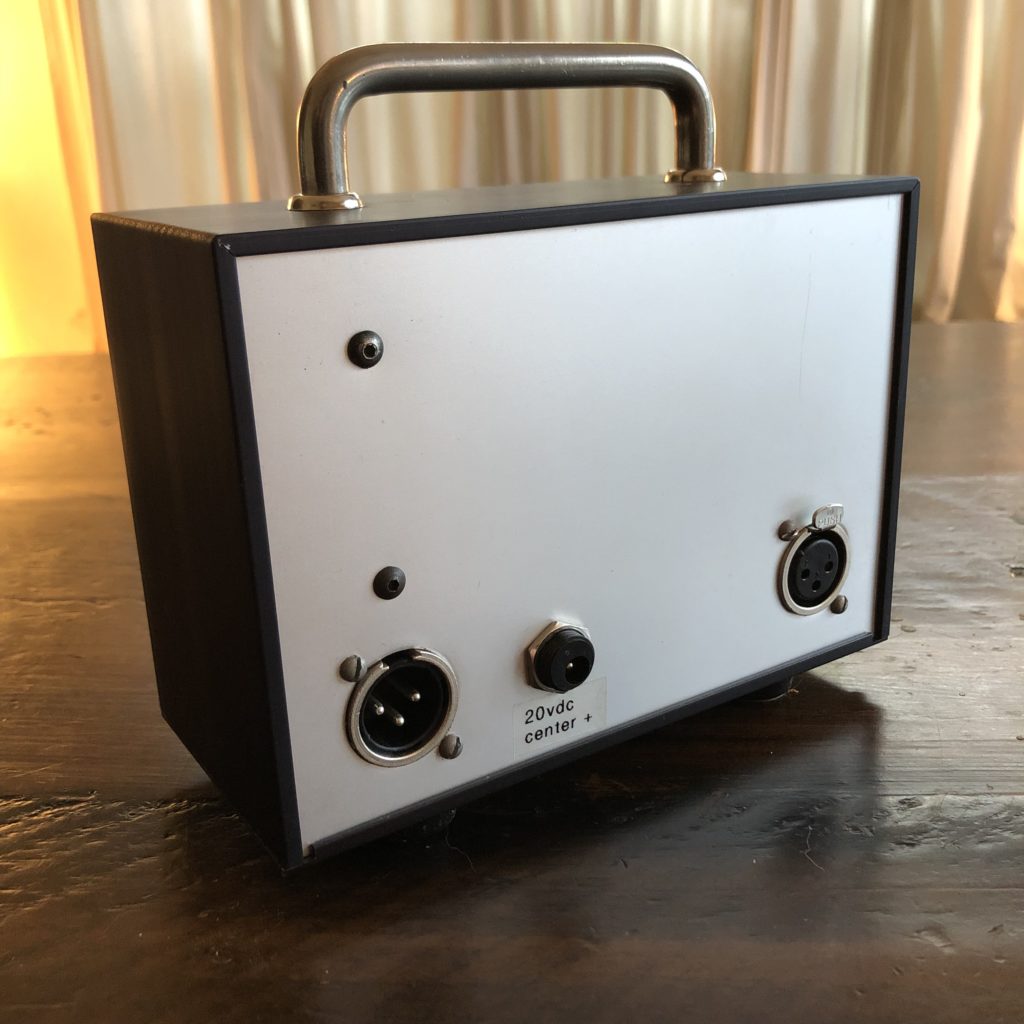
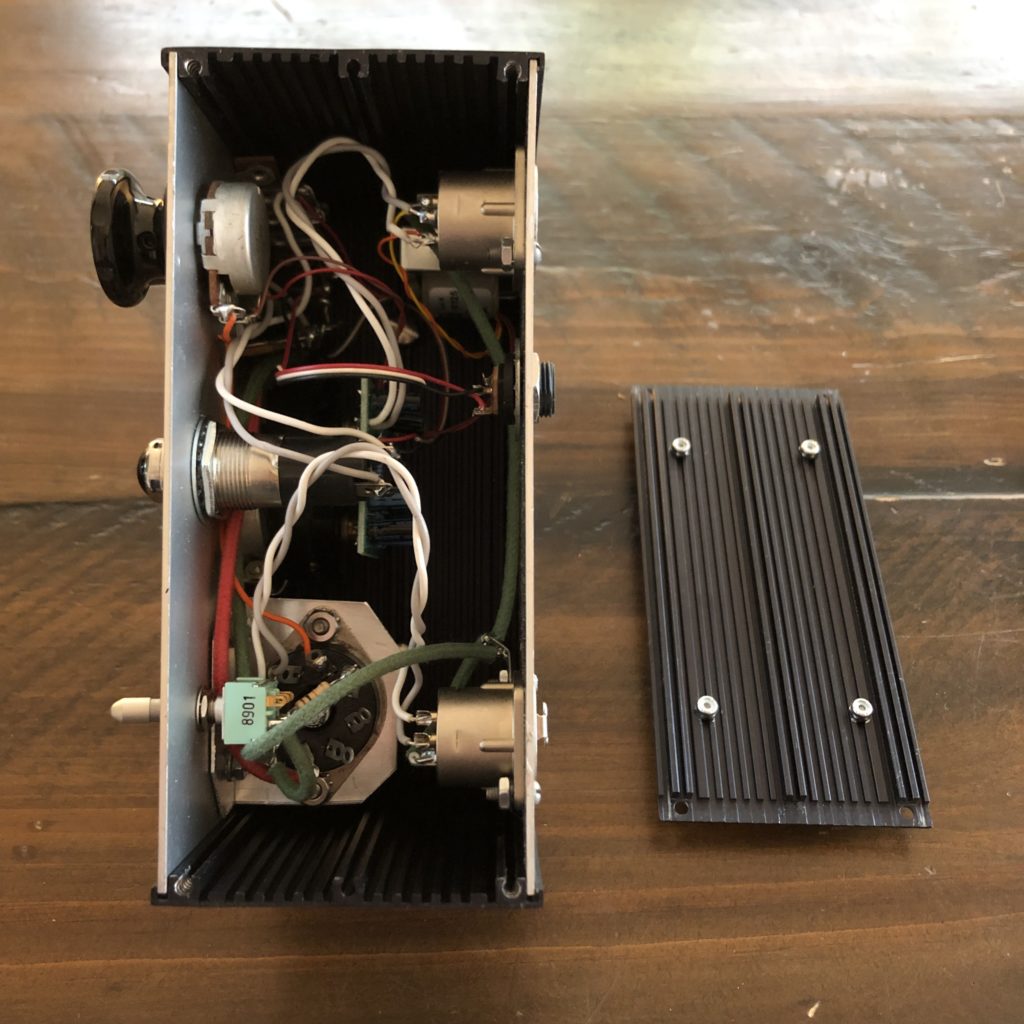
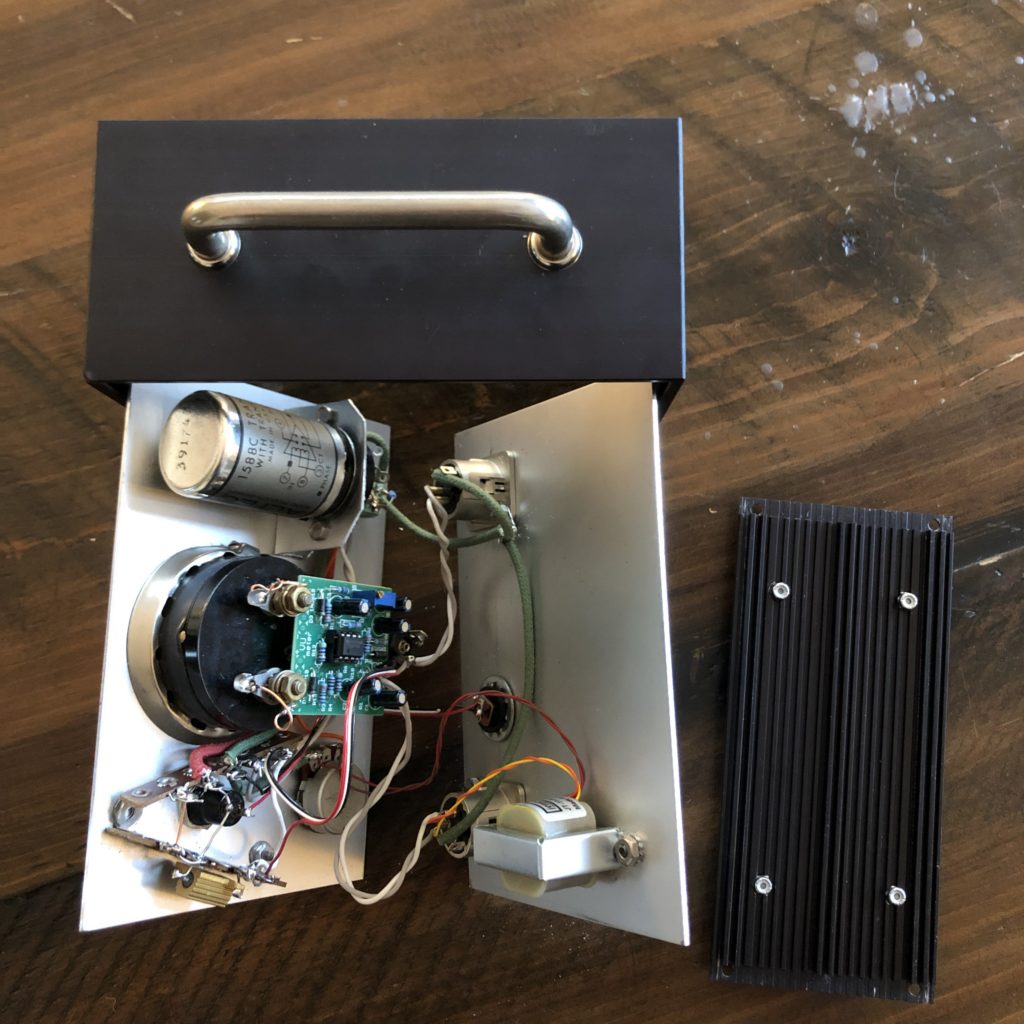
As the photos reveal, the case is comprised of a U-shaped black body with a bolt -on bottom cover; the front and rear faces are polished aluminum and simply slot into channels in the body. VERY sturdy and attractive. If anyone know of a comparable modern product line, please LMK in the comments.
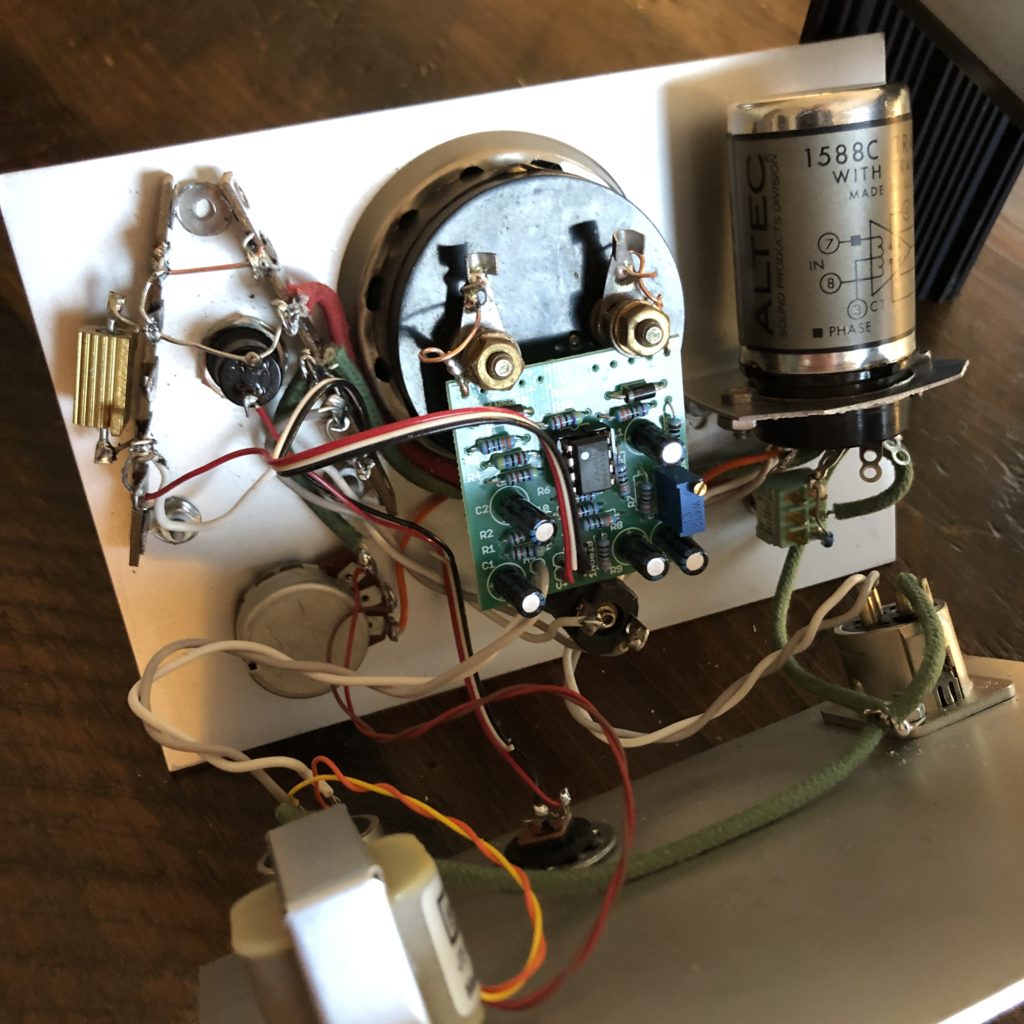
In the photo above (front panel, rear view) you can see the the pot on the lower left; above is the power switch and a 5W 40-ohm resistor that drops the 20VDC from the regulated Dell Laptop supply (free at a hamfest!) to around 11 volts to power the VU buffer amp and the 14v lamp. This is certainly not the most elegant solution (ESP because when/if the bulb fails, the power to the buffer will spike to around 19V), but I couldn’t make the required voltage drop happen with a voltage divider since the DC resistance of the bulb is so low (5 ohms!). Any advice on this that does not require a voltage regulator, pls LMK in the comments…
Anyhow, on the right is the 1588C module, mounted in a standard octal tube socket. The switch below selects if pin 2 sees ground thru either a 100 ohm resistor (‘hi gain’) or a 10K resistor (‘low gain’).
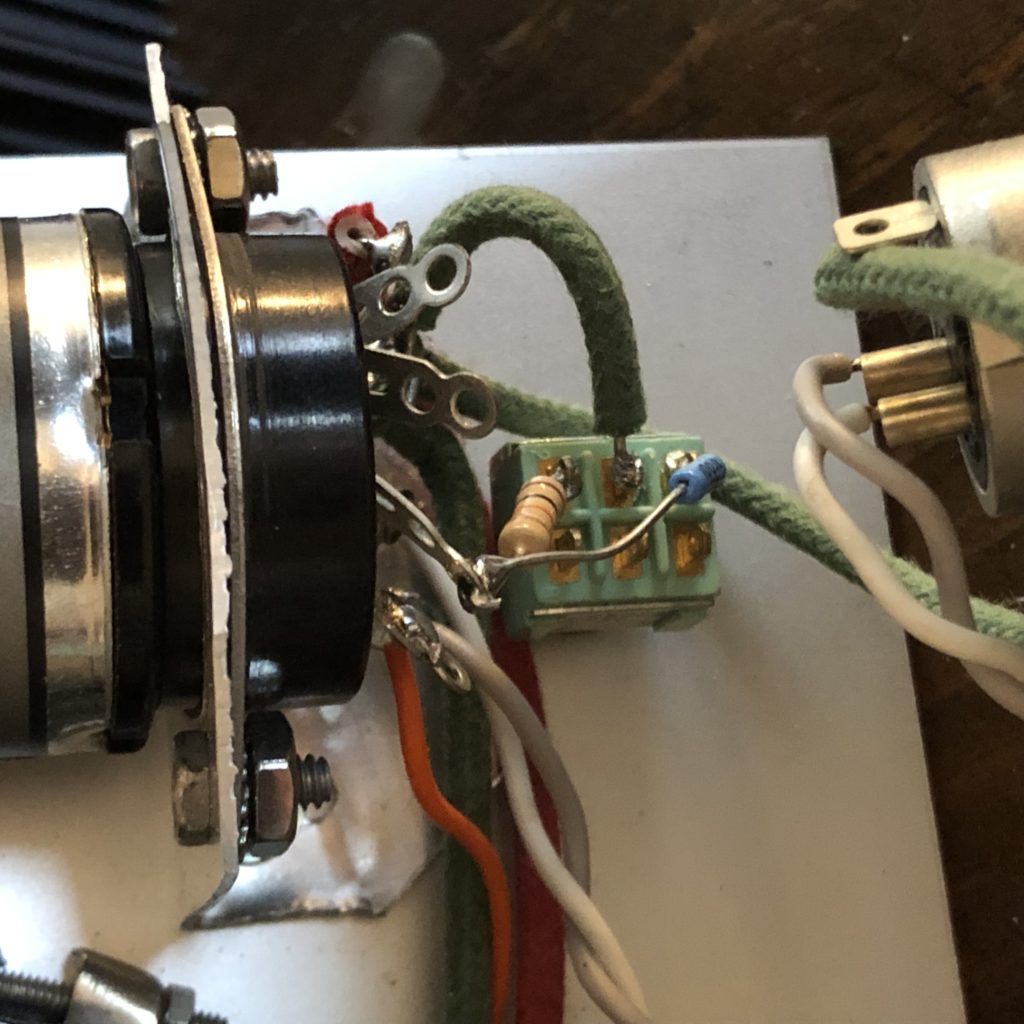
The switch itself is pretty neat; vintage Japanese NOS unit with gold contacts and a ‘pull’ shaft, IE., you need to pull the shaft toward you in order to change its position.
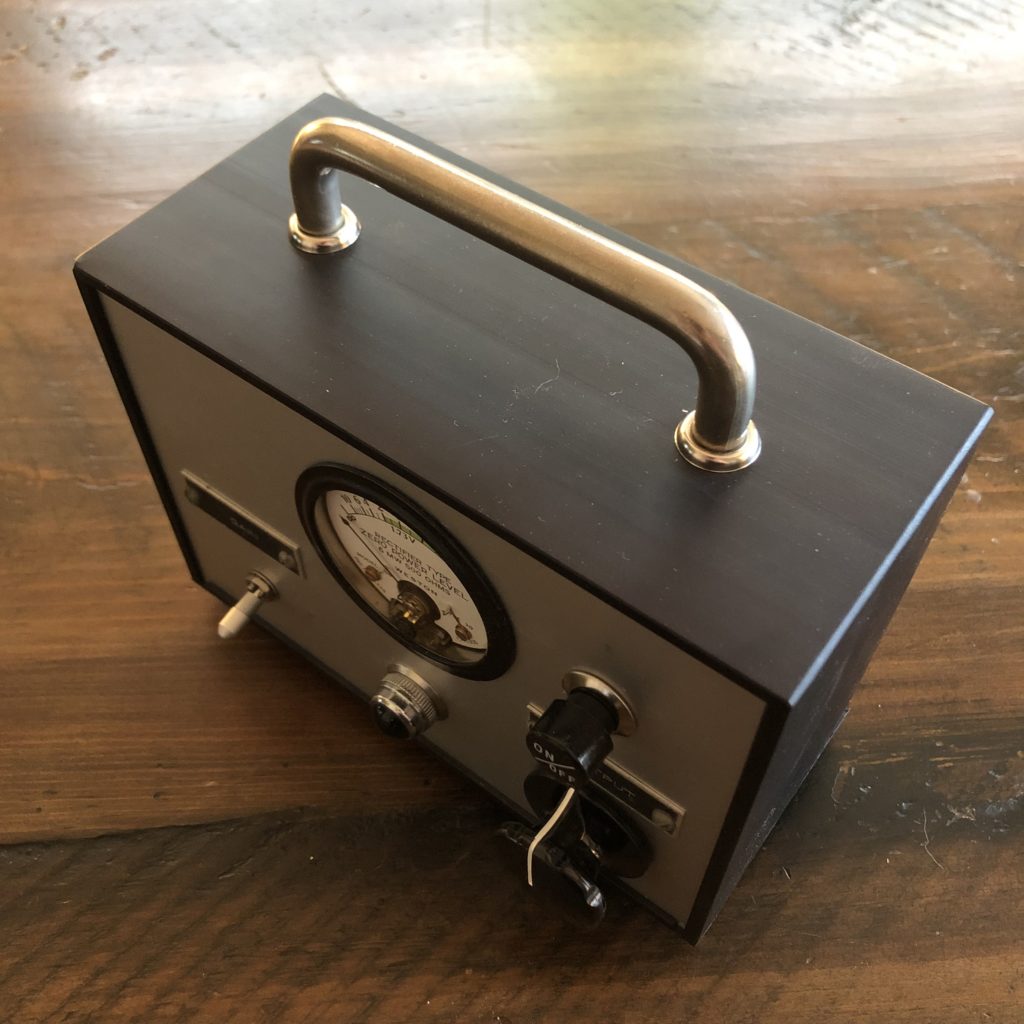
So that’s about it… the sound is very good; very clear, very low noise. Will def be usable for recording. Unfortunately, the frequency performance of the unit is nowhere near the stated specs. Why this is I am unsure. The only external elements in the signal path are the pot and the Jensen Transformer; I certainly trust the stated specs of the Jensen, and if the source impedance of the 1588C is truly 10 ohms, it should have no problem driving a 1K pot. Based on what I’ve described of its implementation here, if anyone knows for sure what the issue is, please LMK in the comments. Anyhow, here’s my test results obtained with the completed unit; I use a LofTech oscillator and a Ward Beck meter for measurements. Signal ref is sine, -40db, 1K hz.
Max gain (low; 10K fb res) = 28.5 fb
Max gain (high; 100ohm fb res) = 38db
Max clean output +14 db
High end down 1db at 7K, 2db at 10k, 5db at 15K, 6db at 20k
Low end down 1 db at 100hz, 2db at 40hz, 3.5db at 20 hz
One final note, and important if you attempt to do this same sort of thing. Of the three 1588Cs that I got in that $30 lot (one used, two in-the-box, advertised as NOS), only one worked well – the first two I tried had issues. The first had a very subtle high-frequency whine, and the other had a non-functional gain pin (it was stuck in a low-gain setting, likely indicating a short within the unit). If I had not had extra 1588Cs around, this would have been an intensely frustrating exercise.
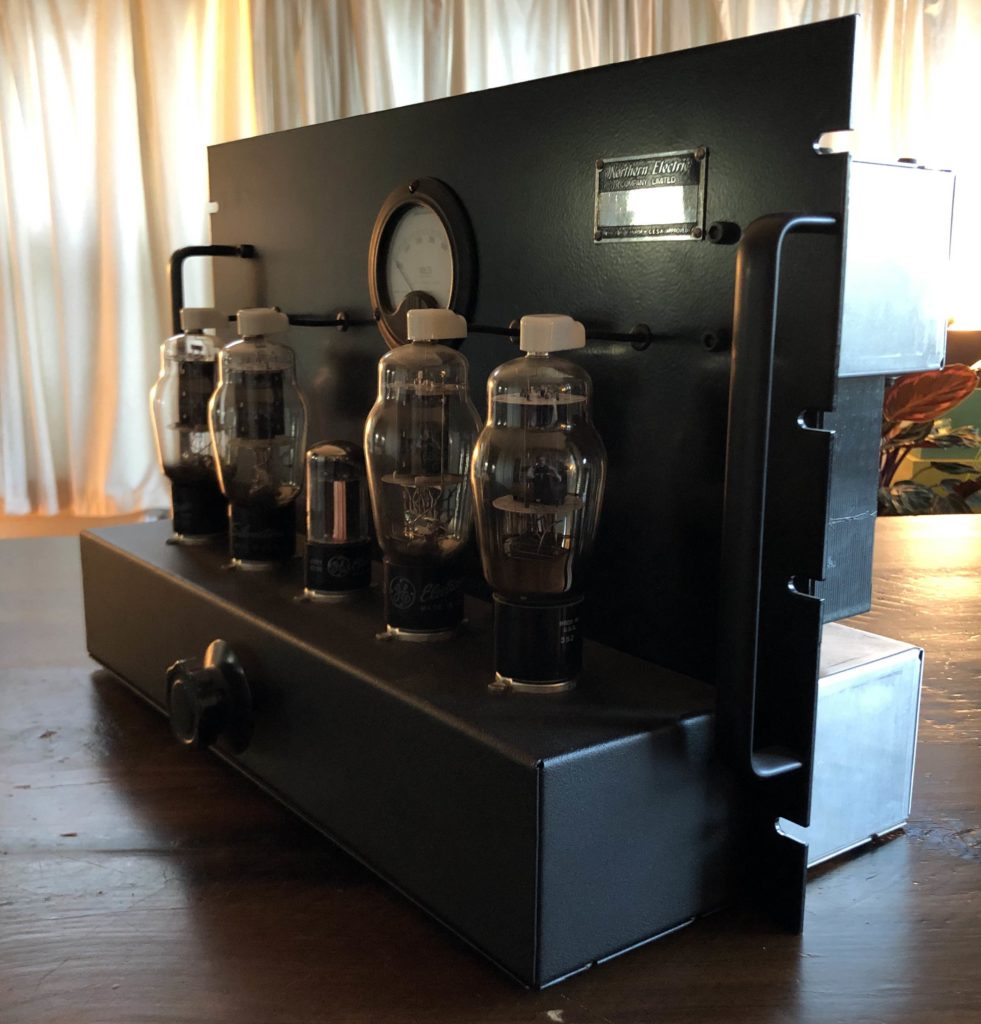
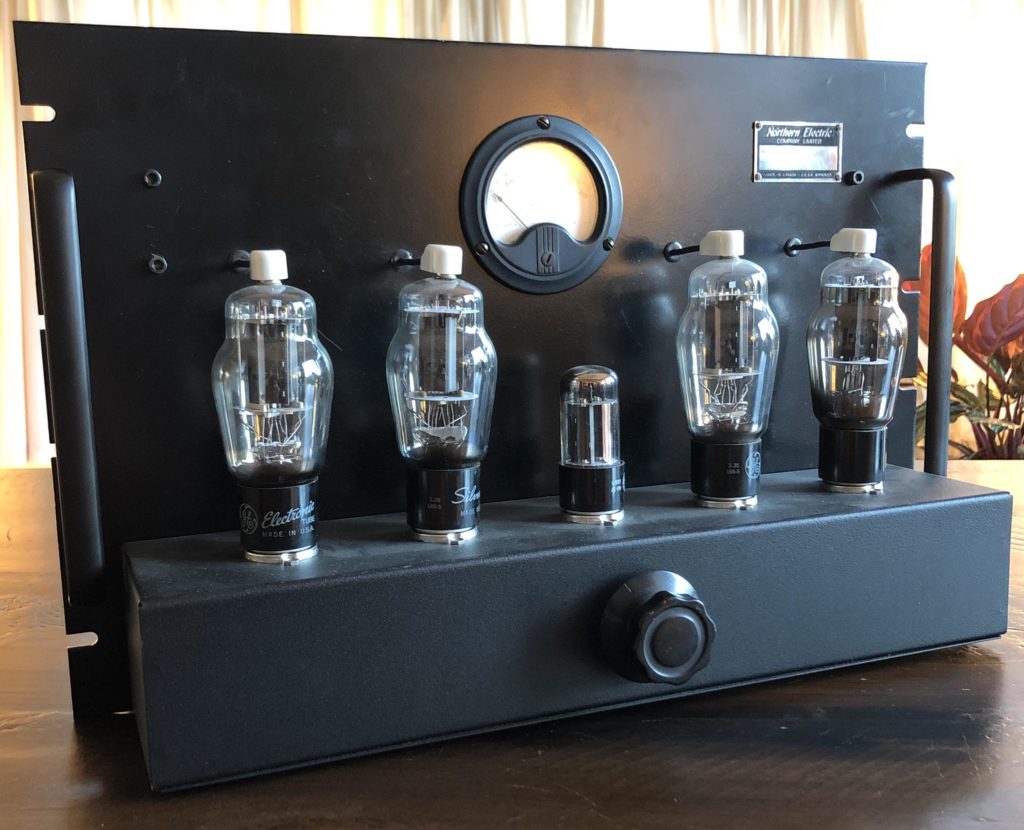
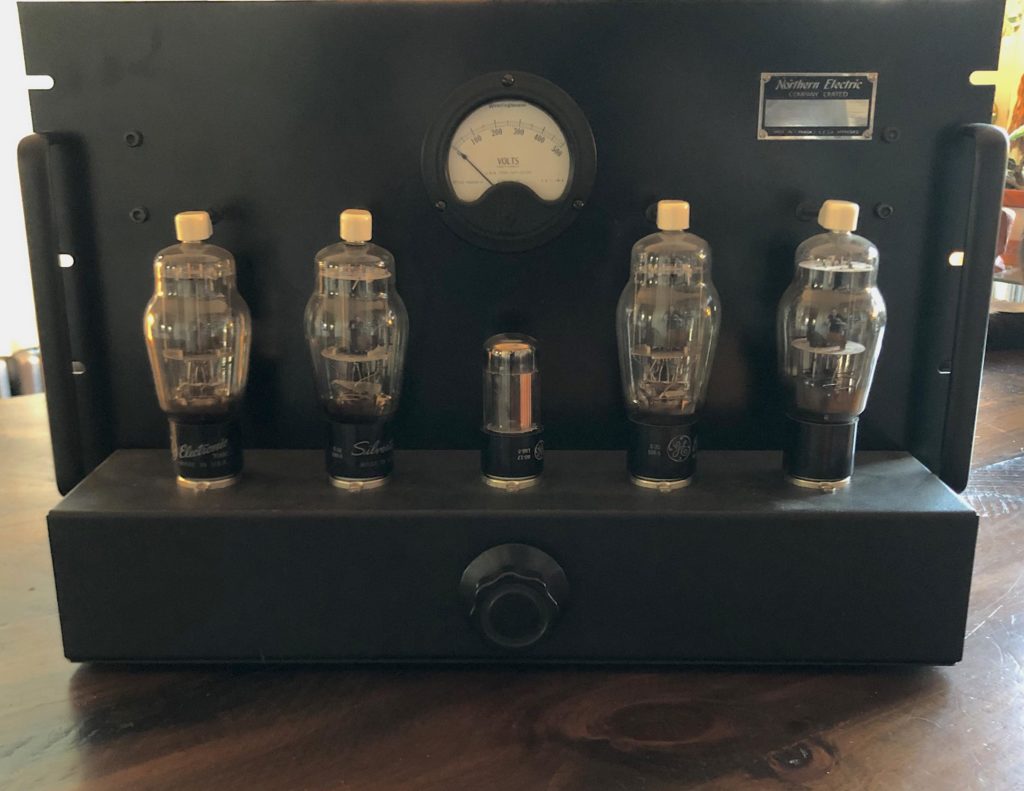
The piece you see above is my homage to the Western Electric 43A. The 43A, as far as I can determine, was the first audio amplifier developed specifically for cinema sound. According to online sources, it was released in 1928 or 1929 – a year or two after the first optical-track sync-sound film was shown publicly. (source, and source).
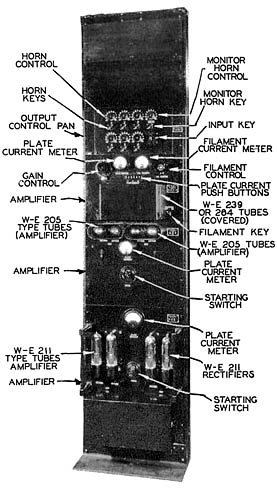
Above is the original context in which the 43A would have been found – it’s the piece on the bottom – and this entire massive apparatus represents a single 20-watt audio playback channel, with all associated power supplies, preamps, and control devices.
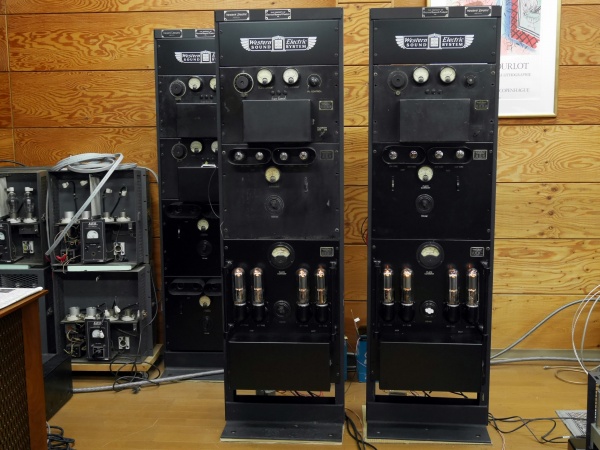
Above, a pair of these systems, as seen recently via a dealer in Japan.
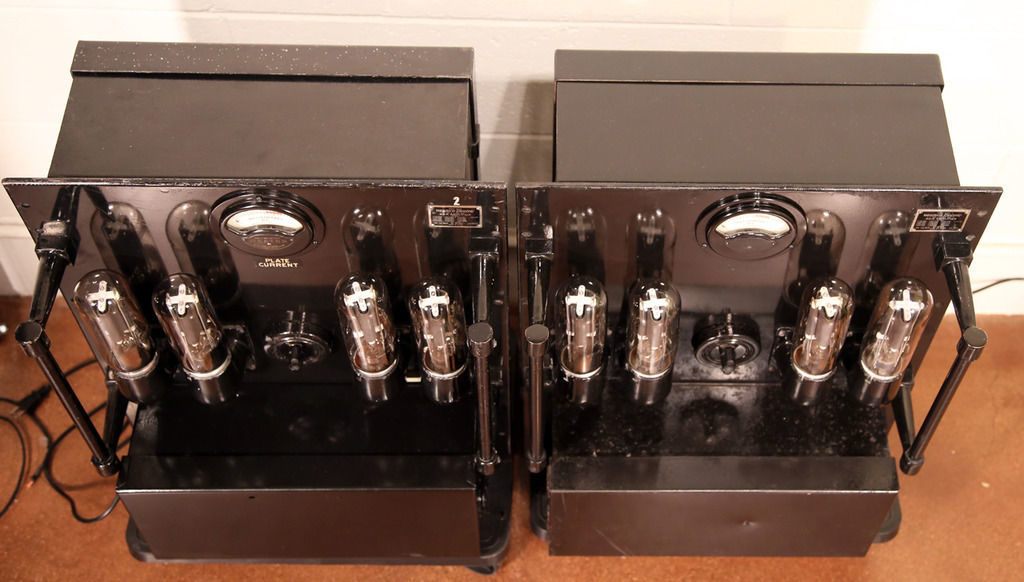
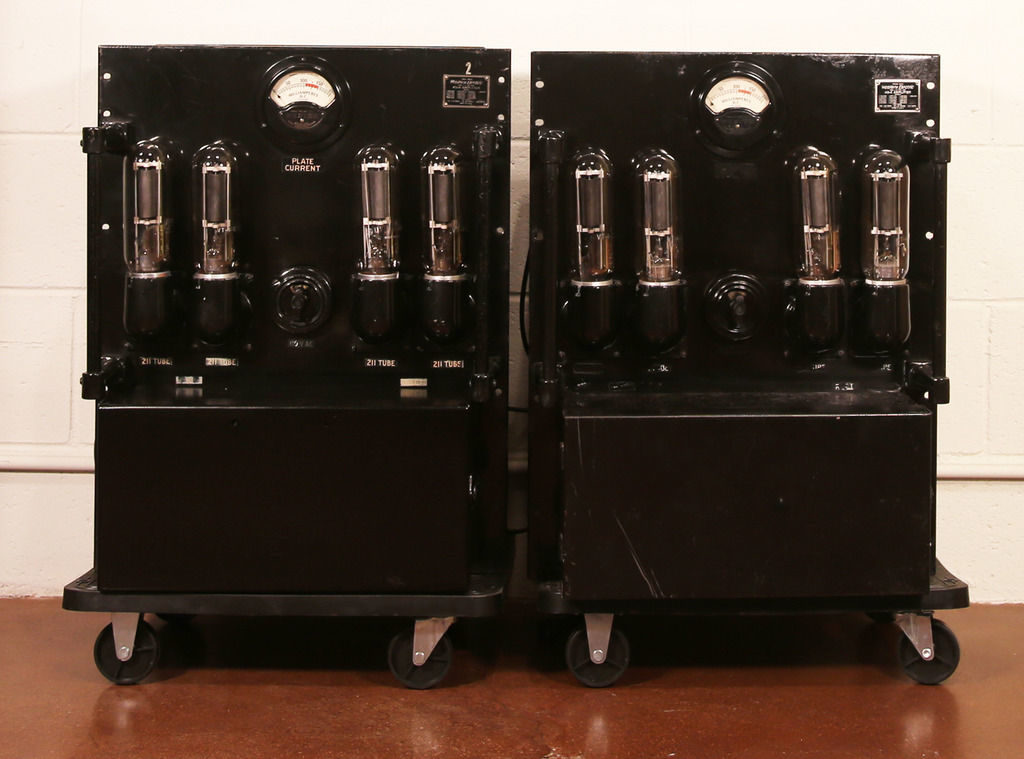
I don’t have a clear sense of how many 43A were made, so I don’t want to add to internet ‘swirl,’ but there can’t be too many out there. Above is a pair of 43A that sold in 2016 on eBay for $32,000. IMO This is a very fair price for such an incredible piece of history, but it’s not a sum I, or many people, are prepared to spend on a hifi amp; hence the idea to create this tribute piece.
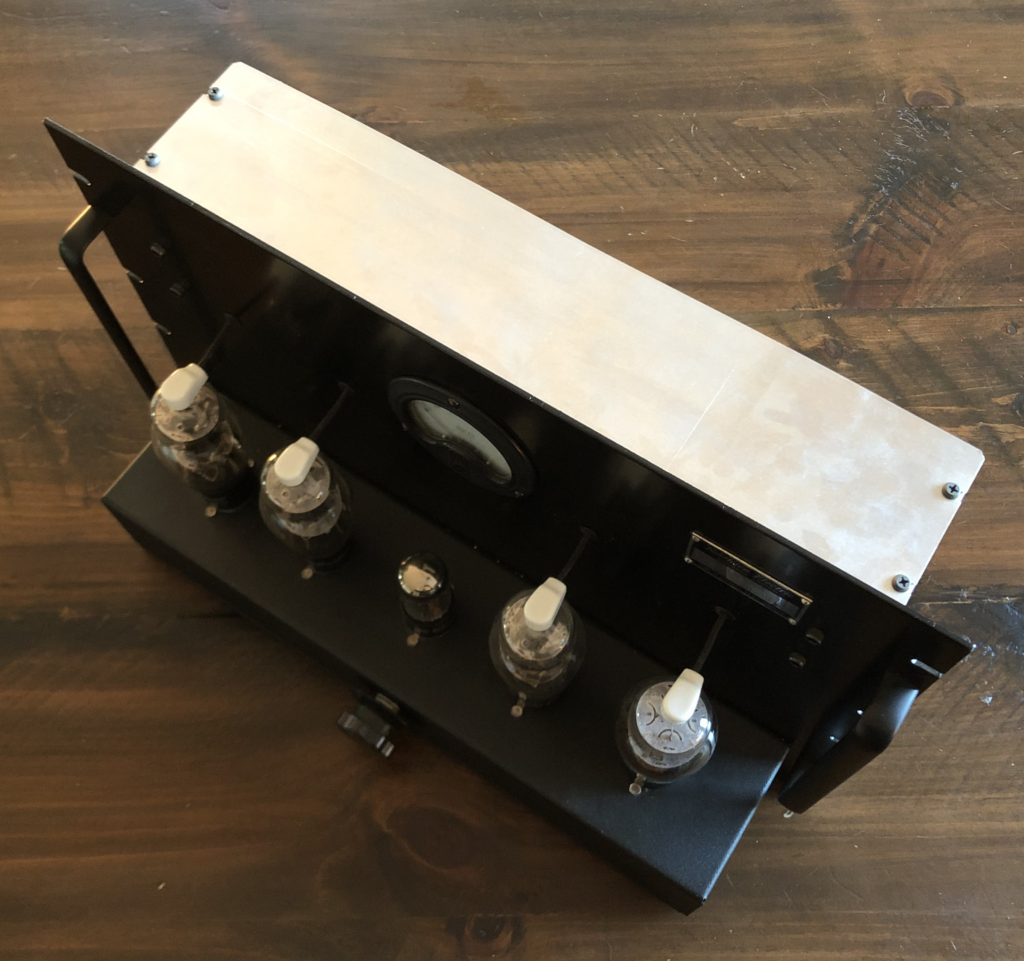
Back to my piece (above)… my goal was not, in any way, to make a copy of a 43A – it would be a fool’s errand, and not very practical – but rather to create a great-sounding and powerful stereo amp that honored the aesthetics of that iconic piece.
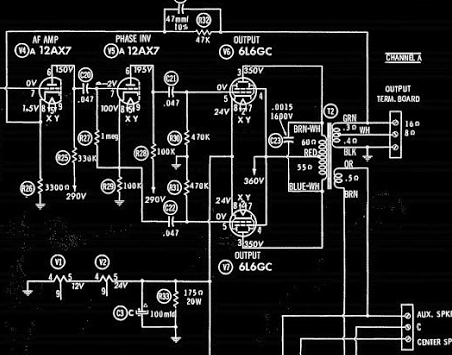
I wanted to use large, dramatic NOS tubes, but at a low cost; coke-bottle 6L6G would be nice but two matched pairs of those would be very pricey. So I subbed 6BG6GA instead. Basically a 6L6 with the plate in the top-cap. I chose the Altec 353A circuit (above), as I have built several Altec 323 and they sound great, and this is essentially the same circuit but using one fewer tube per channel. Since the mechanical construction of this thing was going to be a major PITA, I wanted to keep it as simple as possible electrically. The nameplate is a beat NOS “Northern Electric” mirror-finish plate that I found at Radio Hovsep a few years back.
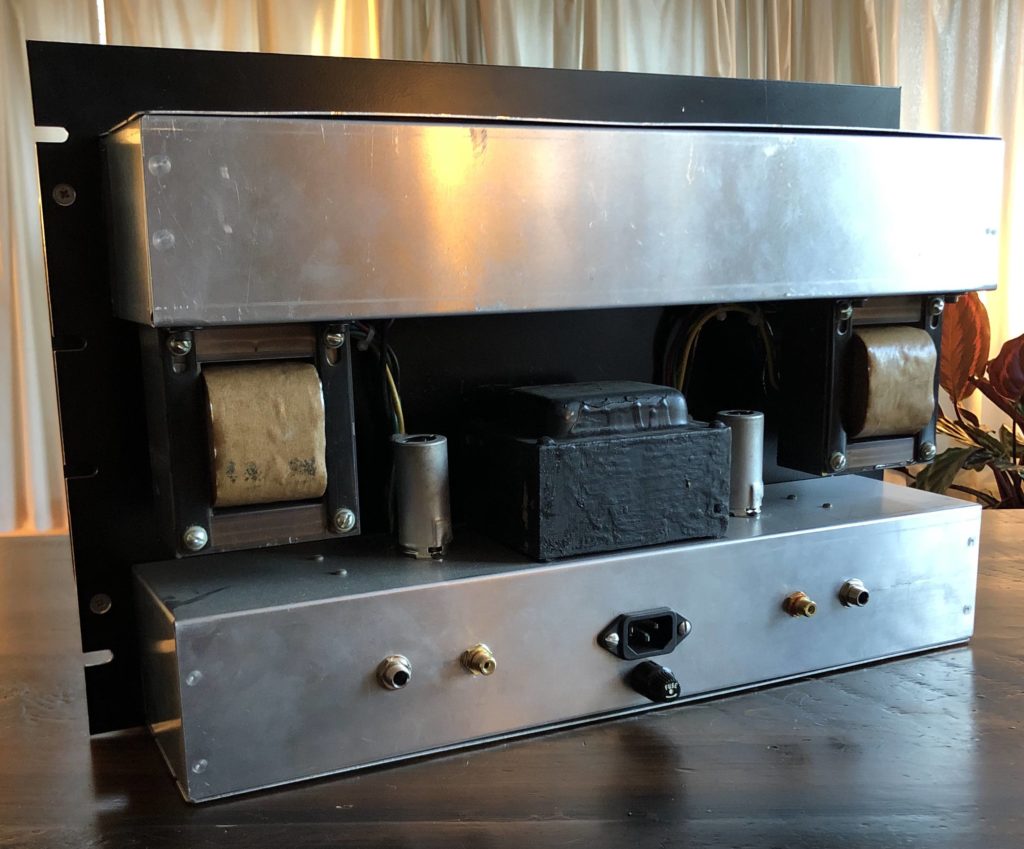
Here’s a shot of the rear. In order to keep hum induction to a minimum, I used aluminum wherever possible in the build. The output transformers (awesome nos 70s40-watt Schumachers with a great vintage look) are suspended from the top chassis in order to keep the plate leads as short as possible. The PT is a pull from an Eico ST70, which has more than enough current-handling ability for this device. The meter is a NOS 1930s 500VDC meter that displays plate voltage. The knob in the center is simply an on-off power control. I am assuming that this will be used with a preamp – probably a ’42 homage’ when I get around to it -although it gets plenty loud as-is with just a CD player connected to the RCA inputs.
This was a very difficult build in terms of the metal work. Getting all the various subchassis to line up was difficult but worth it in the end. It’s incredibly solid and has an imposing aura to it. The use of all Hammond-brand metal components ensured that the black finish(es) would all match and thereby present a unified appearance.
 Shown above is a pair of Preservation Sound “Sienna” model preamps. These are the first designs to wear the ‘Preservation Sound’ name. This is an all-tube design based on the circa 1950 RCA BA2C but with all-mod-cons and 20db more available gain. It has a true class-A output stage like early broadcast gear. Three-band fixed 100/1k/10k EQ, fully reciprocal, with defeat switch and flat center response. Build features include mil-spec tubes, Jensen and Lundahl audio transformers, Solen caps, completely point-to-point wired on linen turret boards with silver wire in the audio path. Completely enclosed design with internal subchassis for shortest possible wiring paths. This is a completely unique design that offers a huge range of sonic possibilities. Defeatable output pad allows user to achieve the ‘overdriven console’ sound of early rock and RnB recordings. Basic specs below:
Shown above is a pair of Preservation Sound “Sienna” model preamps. These are the first designs to wear the ‘Preservation Sound’ name. This is an all-tube design based on the circa 1950 RCA BA2C but with all-mod-cons and 20db more available gain. It has a true class-A output stage like early broadcast gear. Three-band fixed 100/1k/10k EQ, fully reciprocal, with defeat switch and flat center response. Build features include mil-spec tubes, Jensen and Lundahl audio transformers, Solen caps, completely point-to-point wired on linen turret boards with silver wire in the audio path. Completely enclosed design with internal subchassis for shortest possible wiring paths. This is a completely unique design that offers a huge range of sonic possibilities. Defeatable output pad allows user to achieve the ‘overdriven console’ sound of early rock and RnB recordings. Basic specs below:
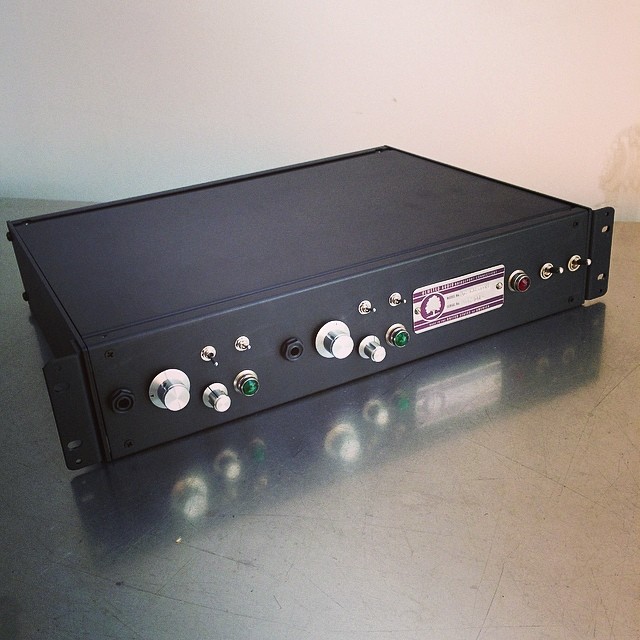 The Akai and Roberts reel-to-reels have circuitry that is largely derivative of the American Ampex machines of the same period, combining an EF86 front end with triode drivers. Anyhow, click here to read my earlier article describing the development of the device. I wanted to capture as much of the vibe of these classic prosumer machines but with a feature set and performance that would make the units suitable for use in a modern production environment. And here are the results:
The Akai and Roberts reel-to-reels have circuitry that is largely derivative of the American Ampex machines of the same period, combining an EF86 front end with triode drivers. Anyhow, click here to read my earlier article describing the development of the device. I wanted to capture as much of the vibe of these classic prosumer machines but with a feature set and performance that would make the units suitable for use in a modern production environment. And here are the results:
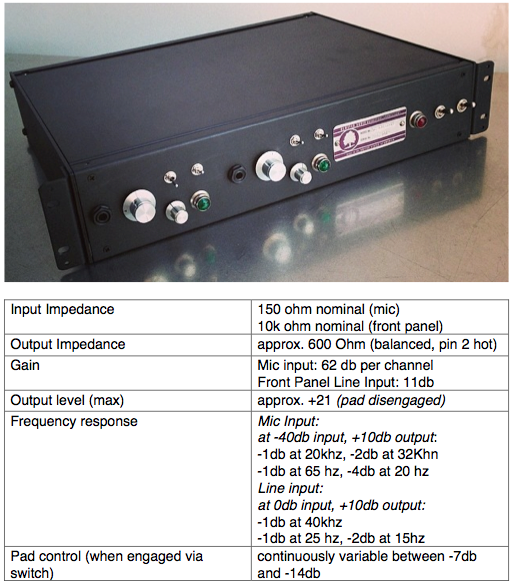 I tested the unit before delivery and was very happy with the results; you can see it here perched above the rack at our studio Gold Coast Recorders:
I tested the unit before delivery and was very happy with the results; you can see it here perched above the rack at our studio Gold Coast Recorders: